- Newsletter Issue Number:
- AICCM National Newsletter No 160 April 2023
National Gallery of Australia
The Objects Conservation team has been preparing works for several concurrent upcoming exhibitions including Haegue Yang: Changing From From to From and Ngura Pulka – Epic Country. Kim Goldsmith is currently in Adelaide deinstalling Yayoi Kusama’s The Spirts of the Pumpkins Descended into the Heavens at the Art Gallery of South Australia. Alysha Redston has been working with The Mulka Project on their work Djarraṯawun, which was projected onto the building during the Enlighten festival. Courtney Crane, Nyx Matthews and Sheida Sabetraftar have been working in the Sculpture Garden, re-waxing Tracy Emin’s When I Sleep. They have also been overseeing the installation of Andrew Roger’s work I am in the Sculpture Garden. This work is a tall enclosed conical form, which presents unique challenges in an outdoor environment, and Nyx has been experimenting with designing custom tools to remove water and debris from the interior to prevent build-ups.
The Paper Conservation and Mountcutting teams have been preparing a large number of works on paper and photographs for external loans, such as the shared NGA regional initiative with Cairns Art Gallery, Warhol and Lichtenstein, and the Art Gallery of South Australia exhibition A Social Media: Andy Warhol and Photography. The Rauschenberg and Johns travelling exhibition, featuring over 80 works on paper from the National Collection, was deinstalled and started its tour in Alice Springs.
Paintings Conservation has been preparing works for the Ngura Pulka exhibition opening in June. This has included stretching 30 very large paintings measuring 3m x 3m.
Preventive Conservation has been working closely with Building Services on several building upgrade projects, including advising on the LED lighting project, which is currently underway.
Textile Conservation has attached the final display mechanism to a series of Arthur Boyd tapestries going on loan next month. Micheline Ford will be travelling to Adelaide with the tapestries to oversee their installation. The Textile Conservation team has also recently deinstalled a series of Ballets Russes costumes to make way for a display of 1960’s fashion and accessories from the collection. In preparation for this changeover, Carmella Mollica has been conserving a pink bouclé Chanel suit back to its original splendour. Tiffany Abbott has been working on mounting the costume International Year of the Child by Annemieke Mein and Costume for a Mourner by Henri Matisse, both of which are headed out on loan to different venues later in the year.
Conservation staff presented papers at the ICOM-CC Modern Materials & Contemporary Art & Textiles virtual joint interim meeting. Michelle Hunter and Melissa Bolin highlighted the textile conservator’s involvement in the costuming and restaging of Justene Williams’ 2022 performance of Victory Over the Sun and Kim Goldsmith presented her work on a pair of 1990’s jelly ‘Eiffel Tower’ sandals by Patrick Cox.
University of Canberra
Another new semester has begun, and the Heritage Conservation Lab is once again buzzing with students learning the theoretical and practical skills of materials conservation. Objects undergoing treatment this semester include among others a retro oil painting on Masonite, a mysterious kimono and a really dirty turtle shell.
We have begun working on the care and conservation of the Faculty of Arts and Design’s Indigenous Art and Artefact Collection, which is aided by a Community Heritage Grant. Our Conservation Lab Manager, Hakim Abdul Rahim, and Wendy Somerville, CCCR’s First Nations Postdoctoral Research Fellow, will begin the long-overdue work of reconnecting the works with the artists and artists’ communities to develop culturally appropriate protocols for the care and management of the collection.
We are very pleased to announce that UC Cultural Heritage PhD student Julia Brand has been offered a new position as a research fellow in laser cleaning at the Victoria and Albert Museum in London. Julia has been publishing like crazy during her PhD and this, as well as her thoughtful suggestions on how she would like to approach the fellowship, clearly impressed the panel. As well as this being a huge coup for Julia herself, we are very excited that the use of lasers in conservation is receiving more and more attention. While not a tool for everything, lasers are much more environmentally sound than many of our current armoury of chemical and abrasive-based cleaning techniques so offer opportunities to save our planet as well as our heritage. Julia will leave us at the end of the year and while we extend our warmest congratulations to her on this exciting new chapter in her career we also have an eye on the future possibilities for collaborative research and other opportunities. Julia has not heard the last of us …
Art Gallery of NSW
The AGNSW team has been enjoying the fruits of the new North Building (SMP—Sydney Modern Project), which opened to the public in early December 2022. After several years of planning and preparation, the new building welcomed thousands of visitors in its first few weeks who came to enjoy the extraordinary SANAA-designed building, which offers spectacular views of the city and harbour. With seven new galleries, including a subterranean space (formerly a World War II oil tank supplying the naval fleet at Garden Island), the team is absolutely delighted to be able to support the display of art in these unique new spaces.
Paper Conservation
The team recently welcomed Kate Hughes to the position of Senior Paper Conservator. Kate has been thrown straight into life at the Gallery working on The National 4: Australian Art Now, which includes several complex multi-part works on paper by artists including Brenda Croft, David Sequeira, Glen Mackie and Heather B Swann. Lois Waters has been busy preparing works for inclusion in World Pride displays across the Gallery in addition to working on several fascinating works from the Asian Collection for changeovers in the Asian Lantern Galleries. Keyeele (Kiki) Lawler Dormer has been working closely with the photography team on a significant project to digitise the work of women artists in the collection. To date, Kiki has prepared over 500 works for photography, allowing these works to be made available on the AGNSW website, and in turn increase their potential for display, loan and research. Grant Hawkes and Ju Bavyka have been working on a range of projects including the mounting of works for the Young Archies, which will hang as a sister display to the Archibald, Wynne and Sulman prizes. Analiese Treacy has been working through a number of new acquisitions including a large gift from author and researcher Jim Masselos. The gift of over 300 works includes Indian miniatures form the 16th century through to Company School paintings and Indian folk art paintings of extraordinary colour and craftsmanship. The loans program is back up and running after a period of moratorium, and works are being prepared for loan to the Jewish Museum of Australia, National Gallery of Victoria and others.
Frames Conservation
The Frames team welcomes Emma Northwood, who is completing a three-month internship at the AGNSW from the University of Canberra. Emma has been working with the team on a number of projects including a frame treatment of an early acquisition watercolour. Emma has also had the opportunity to do a site visit to the ANMM. Barbara (Basia) Dabrowa has recently completed two major frame treatments on watercolour paintings by Australian artist BE Minns. These works are amongst the Gallery’s earliest acquisitions and are due to go on display in the Grand Courts in May. Genevieve Tobin has been working on a major frame treatment on Thomas Francis Dicksee Hermione (c. 1875) painting, which has had extensive filling and reconstruction and is progressing to ornament loss compensation stage.
Reproduction Framing
Tom Langlands has been busy completing a large ornate frame on a Louise Hersent painting in time to be displayed in the Grand Courts on International Women’s Day. The frame involved significant research in consultation with the Curatorial Team and fellow frames conservators, to ensure the most suitable style of frame was chosen. Other frame projects include reproductions for three Conrad Martens watercolours, a contemporary frame for a work by Anne Montgomery, and black box frames for a group of large-format photographs by Christian Thompson.
Paintings Conservation
Celine de Courlon has been working on the standardisation of documentation and photography across the conservation department. She has been working with other departments on building works in the North and South gallery building. Celine is working in close liaison with the curators on the exhibition changeovers for both gallery buildings. Selina Halim has joined the team as Senior Paintings Conservator. She has been thrown into the deep end from the get-go, with a thread-by-thread treatment on a torn painting, treatment of Joseph Backler portraits and the preparation for the World Pride exhibition. Selina has been working in close collaboration with Genevieve Tobin from Frames to apply her xPVOH solvent gel technique on paintings. The collaboration is highly successful, and they are both looking forward to sharing their findings with the rest of the conservation team. Madeline Ewing has been busy assisting with the Daniel Boyd artwork deinstallation, World Pride exhibition preparation and The Nationals 4: Australian Art Now installation. She has also been treating and preparing nine William Turnbull paintings, which are being returned to the artist’s estate. Andrea Nottage has been working tirelessly on the Willem Key portrait, as the benefactors-funded project for the rehang in the Old Court. Simon Ives has completed the treatment of a new acquisition by Louise Hersent, which has had a new reproduction frame, and a painting by Clarice Beckett. He is currently working on the returned Furnishing Loans with the recent change of government. The team has recently had a group training with a Thermo Fischer representative on the FTIR and FTIR-ATR equipment and software.
Objects Conservation
Kasi Albert has rejoined the team at the Gallery as Senior Objects Conservator after five years at the Museum of Contemporary Art. She has hit the ground running, working on new acquisitions and complex multicomponent works for The National 4: Australian Art Now, including works by Heather B Swann, Madeleine Kelly and Nabilah Norden. Objects conservators have been involved with preparation and installation of AGNSW collections artworks for the Upper and Lower Asian Galleries, and for the World Pride changeover in the LL1 Australian galleries. Sofia Lo Bianco undertook conservation treatment of the Dennis Golding commission in the vestibule for World Pride and other World Pride collection displays, including a major treatment on a collection artwork by Jim Hodges. She is also undertaking major structural works on a number of artworks by artists Phyllida Barlow and Pascale Marthine Tayou in addition to recently acquired collection works by Adrian Villar Rojas. Ash Gilmore has been working on the changeovers in the Asian Lantern Galleries, preparing a wide range of works including textiles, sculpture and contemporary artwork. She has also been consulting with stakeholders on the care and maintenance of interactive works by Jeffrey Gibson in the exhibition Dreamhome. Bronwyn Tulloch has been working on the care and maintenance of all things large and challenging, including the outdoor sculptures in the new North Building such as the works of Yayoi Kusama and Francis Upritchard. Objects Conservation is currently joined by student Aourelle Cohadon, who has come to Sydney from the Institut national du patrimoine in Paris as an intern with us for five months. She has already assisted with a great variety of tasks and has visited several other conservation labs in the city.
Time-based Art (TBA) Conservation
Carolyn Murphy, Lisa Mansfield, Rebecca Barnott-Clement and Juanita Kelly-Mundine are all working on the Australian Research Council (ARC) Linkage project Precarious Movements: Choreography and the Museum. Bringing together academics, curators, conservators and artists from diverse institutions, this project aims to interrogate the relationship between dance and visual art practices and institutions since the turn of the 21st century, developing solutions for emerging and associated challenges for artists and art workers. For the collection work Sonix, circa 1969, by Stanislaus Ostoja-Kotkowski, TBA Technician Jonathan Dennis has been researching and testing legacy equipment to determine future functionality, and to update the artwork preservation plan. This work is in collaboration with Objects Conservation and Charles Lawler, AV Exhibitions Technician, as part of the AGNSW Obsolete Technology Project. Our team is thrilled to be welcoming recent Grimwade Centre masters graduate Emma Ward and Grimwade Centre masters student Asli Gunel to work with us on all things TBA for the next six months.
Digital Preservation
Carolyn Murphy, Joanna Fleming and Rebecca Barnott-Clement participated in a two-day workshop in February 2023 as part of the current ARC Linkage Project Archiving Australian Media Arts: Towards a method and national collection. Led by Associate Professor Melanie Swalwell (Swinburne University), this project seeks to develop a best practice method for stabilising and preserving Australian media arts heritage and to investigate approaches to access and exhibition of this heritage. This project represents a major achievement for Australian digital arts conservation with 11 organisations (universities, national art institutions, and leading cultural and media organisations) collaborating to research and develop best practice for digital media arts heritage through key case studies.
Exhibition and Loans Conservation
Sarah Bunn has been busy touring regionally with the Archie 100: A Century of the Archibald Prize exhibition, which is currently being deinstalled at Bathurst Regional Gallery before heading to the Museum and Art Gallery of the NT. Sarah has also been working on a number of upcoming inward loan exhibitions that the Gallery will be hosting towards the end of the year including Hoda Afshar, Kandinsky and Louise Bourgeois: Has the Day Invaded the Night or Has the Night Invaded the Day?
Preventive Conservation
Newly appointed Preventive Conservator Jessica Gray-Hart has been expanding the Gallery’s analytical equipment with the procurement of a FLIR MR176 Imaging Moisture Meter and a Wintact IC-WT63B Vibration Meter. These will assist in ongoing monitoring and investigation of buildings and exhibitions. The IPM program will be rolling out hardcover insect traps to all non-public collection areas in line with the Gallery’s sustainability plan to reduce waste production.
Australian Museum
Collection Care and Conservation
Staff news
Congratulations to our Conservation Manager, Heather Bleechmore, for being awarded the IIC Fellowship recognising her achievements and great contribution to the field!
Sydney World Pride
The Australian Museum put on many events to coincide with Sydney World Pride. It feels good to know your institution supports and empowers visitors and staff, and we hope to see that this visibility leads to actual outcomes for LGBTQ+ staff in the GLAM sector and beyond.
World Pride saw the public reveal and instant iconisation of Progress Shark, a work by Sydney artist George Buchanan. The shark was immortalised across Sydney in many ways, including in a drone light display. Here it is (below right) depicted in the Museum by artist Leon Fernandes. Progress Shark stole hearts and decorated social media pages for weeks and can still be spotted today on the corner of Park and William streets.

The shark statue on the corner of William St and College St is adorned with the colours of the LGBTQ+ community as part of the World Pride celebration in Sydney. © Australian Museum, image credit: Abram Powell.

A work by artist Leon Fernandes inspired by Progress Shark. Image credit: Australian Museum.
Collection Enhancement Project
Clare, our Collection Enhancement Project Natural Sciences Conservator, continues her outstanding work! Another week of careful and considered work in the entomology department has seen her developing new approaches to specimen conservation of particularly fragile and significant type specimens, this week focusing on the stabilisation and repair of weevils and termites. (See her work below.) We think Clare deserves an induction into the conservator hall of fame for her amazing work.
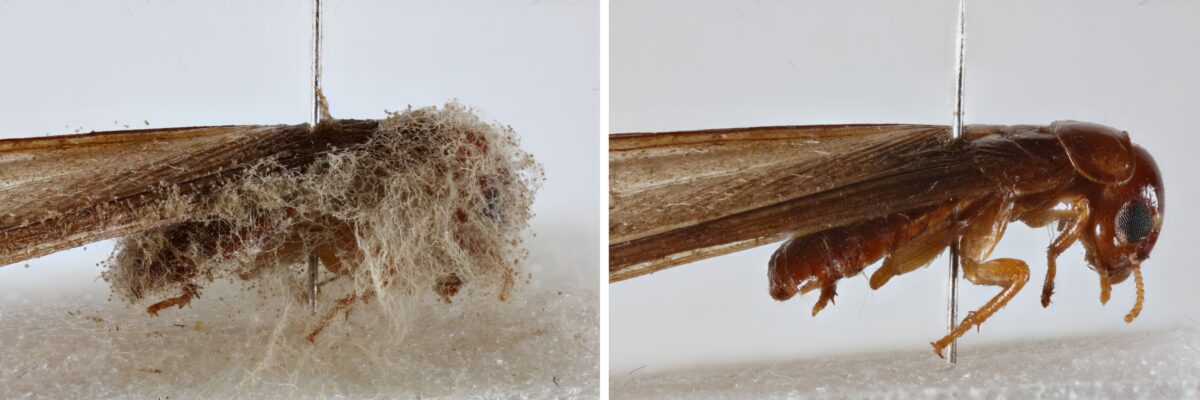
Before (left) and after (right) treatment images of a termite, 2023.02.10. Image credits: Clare Kim.
Exhibitions
Kyra Kim, Lizzie Reed and Melissa Holt have been busy getting ready for the upcoming Bilas: Living Culture exhibition due to open in June. This exhibition will showcase photographs from Wylda Bayron alongside cultural material from the Australian Museum’s Papua New Guinea collection. Bilas encapsulates all types of body adornment and decoration, ranging from masks, body ornaments and bilums, to feathered headwear. The team has been busy treating and packing this family of fragile body masks from Kagua, Southern Highlands, Papua New Guinea.
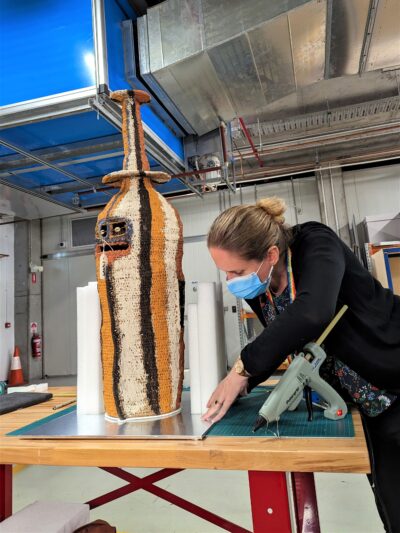
Lizzie packing a body mask for transit. Image credit: Kyra Kim
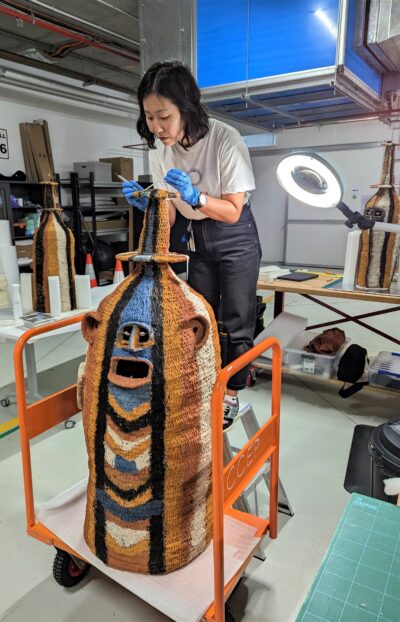
Kyra consolidating friable pigment on a body mask. Image credit: Elizabeth Reed.
Historic Cases and Historic Crocodiles
Sophie has been snapped up by our crocodile, who decided to get closer to the public action and will now be keeping a keen eye on our visitors’ bags and belongings while they are enjoying the Museum. The large historic case, which houses three taxidermied crocodiles (including a saltwater specimen over four metres long) and several snake casts, is being moved from the Surviving Australia gallery to the cloaking foyer in preparation for the gallery redevelopment in a few months. Wrestling and moving the enormous croc has not been an easy task, but Sophie, with lots of help from the amazing preparatory and exhibitions teams, has maintained her prowess and delivered the beautiful beast safely to its new home with no (crocodile) tears shed. The croc enjoyed a conservation pedicure (minor stabilising treatments) before going back into the case. A round of aCLAWS for our Sophie!
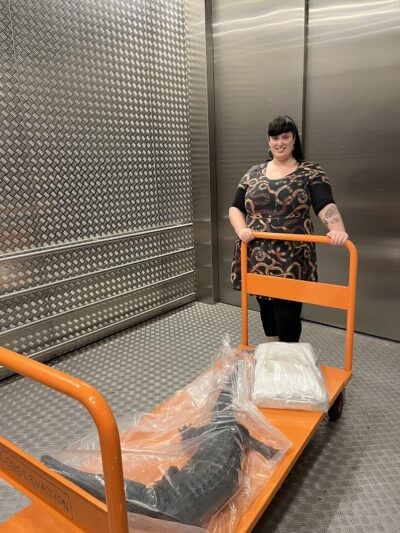
Sophie Phillips transporting a taxidermied crocodile. Image credit: Elizabeth Reed.

An aged and venerable crocodile, on display for several years, finally gets out of its case and it’s been doing just fine—getting a thorough claw treatment with lashings of Lascaux and Japanese tissue paper. Image credit: Sophie Phillips.
Collection Care
Collection Care has been able to fill its calendar with a variety of great, interesting, and satisfyingly bizarre projects. The beginning of the year is always an exciting time for the IPM-inclined, with the slowing down of the pest season. But while the bugs slow, other challenges arise. The nitrogen chamber has been busy, and unfortunately will no longer be available for other users this year due to the Australian Museum’s workload.
Collection Care has started to engage an external indoor air quality contractor and will hopefully be able to discuss the results this year with interested colleagues. Reach out if this sparks your interest!
There has been a renewed interest in starting to better understand the crushing amount of data that a collection care program can generate. Initial investigations are illuminating and hopefully will lead to the development of a streamlined approach to data analytics, and hopefully some developments in database management. Now that all the treatment conservators have stopped reading, just amongst us preventive conservators, who wants to start looking at data on a holistic regional/national level? Reach out to the team and we can start collaborating!
Conservation Dreams of Decomposers
Conservation Dreams of Decomposers is a composite artwork—we do a lot of skeletonisation and preparation of large mammals out in the field, and in areas we want to keep quite secret. This was an artistic response to wanting to share that work but not being able to share actual images of what we are doing. The result is quite ethereal and beautiful, so we decided to turn it into a full artwork with title and year.

Conservation Dreams of Decomposers (2023), Anonymous. This photographic artwork overlays the work of conservators and preparators, developing a better understanding of animal preparation and skeletonisation through composting.
Australian National Maritime Museum (ANMM)
Collection Care

Jeff Fox with some of the Saltwater bark paintings

And Tyson with ArtSpace, discussing the collection.
When conservator Jeff Fox selected a number of barks from the Saltwater Collection to assess and condition check, curators Matt Poll (Manager Indigenous Programs) and Tyson Frigo (Indigenous Program Curator) jumped on the chance to invite ArtSpace, Australia’s leading interdisciplinary space for the production and presentation of contemporary art, to have a look. These barks are representative of the people of the Yirritja moiety of the Gumatj clan in the homeland of Biranybirany. They form part of a series of 80 bark paintings produced by Yolngu traditional owners of East Arnhem Land in an effort to educate outsiders of their stories, land and sea rights, and laws, and are an incredibly significant collection held at the Museum.
Large projects

A tiny Nick Flood on HMAS Vampire as it sails to Garden Island (two views)
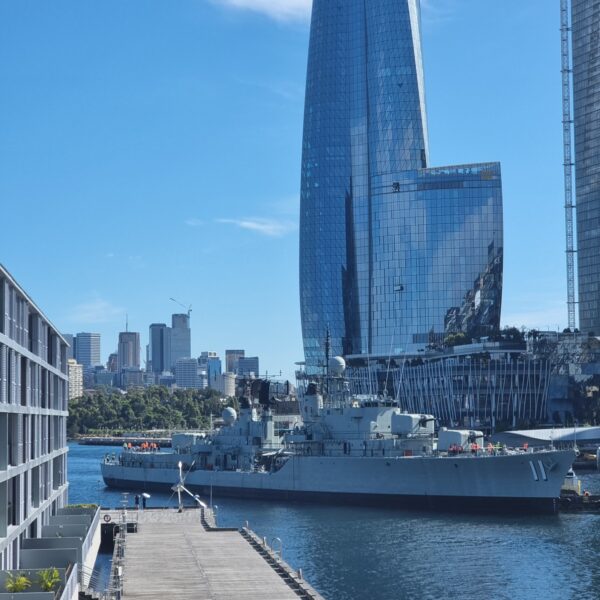
A tiny Nick Flood on HMAS Vampire as it sails to Garden Island (two views)
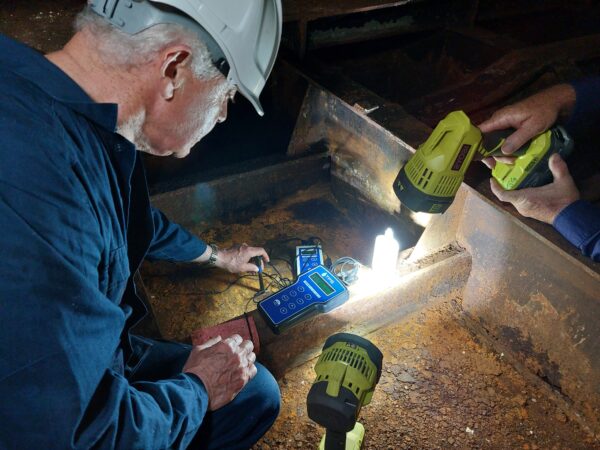
Dr Ian MacLeod undertaking corrosion measurements on the internal structure.
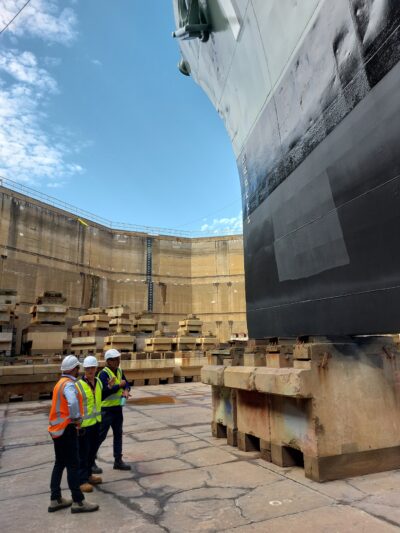
ANMM members observing the underside of HMAS Vampire when it was dry-docked
Nick Flood travelled on HMAS Vampire to Garden Island to help with its maintenance works, and Dr Ian MacLeod was also invited by the Museum to help with the internal assessment of the vessel. Whilst mostly working at Garden Island, Ian popped into the Museum for a few days once Vampire was back.
Exhibitions

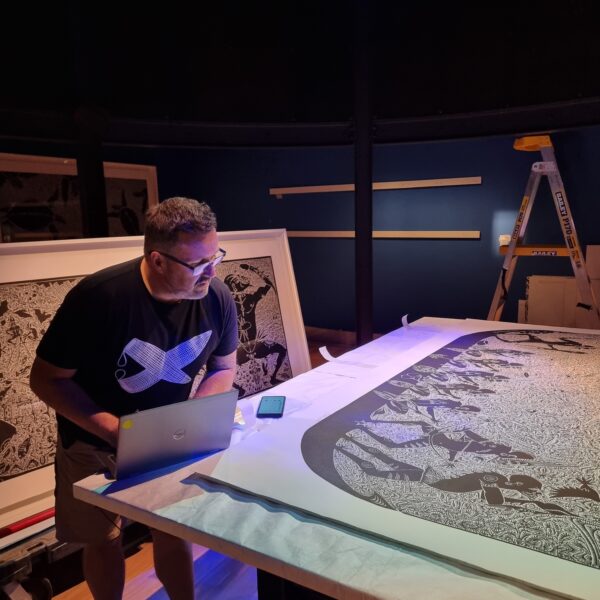
Jeff condition reporting the bronze dugong sculpture and one of the large prints

the gallery space in the midst of Sophie Brown and her team deframing and reframing.
Jeff took the lead on the deinstallation of Mariw Minaral. The task was broken down into two parts: removal of the large objects from the space – like the 200 kg bronze dugong sculpture – and deframing and reframing the large 2D works. The exhibition has been flagged for travel, and the conservation team found it necessary for the oversized prints to be reframed into far less heavy frames. We were lucky enough to have Sophie Brown (from Sophie Brown Conservation Framing) and her team of Jane and Frederique supply the lightweight but durable aluminium frames and float mount the prints. As the prints were so large, the work had to be undertaken within the gallery space. Jeff is currently finishing the frames off with Marvelseal so the works will be protected during their five-year travels.

Alayne Alvis treating the ningher before it can be wrapped for freezing.
After installation of Brickwrecks in December, Alayne Alvis has moved on to working on several new exhibitions, changeovers and installations. She is preparing the ningher for pest treatment so that is can eventually be installed in Deep Time. After being condition reported by the interns last year, Alayne will clean and install the lenticular lens for Serving Country in April. She is also preparing objects for a small installation on the America’s Cup in the Wharf 7 exhibition space, and cleaning and preparing the remaining painted wooden fish for Guykuda’s aquarium, all of which are being hung within the exhibition space.
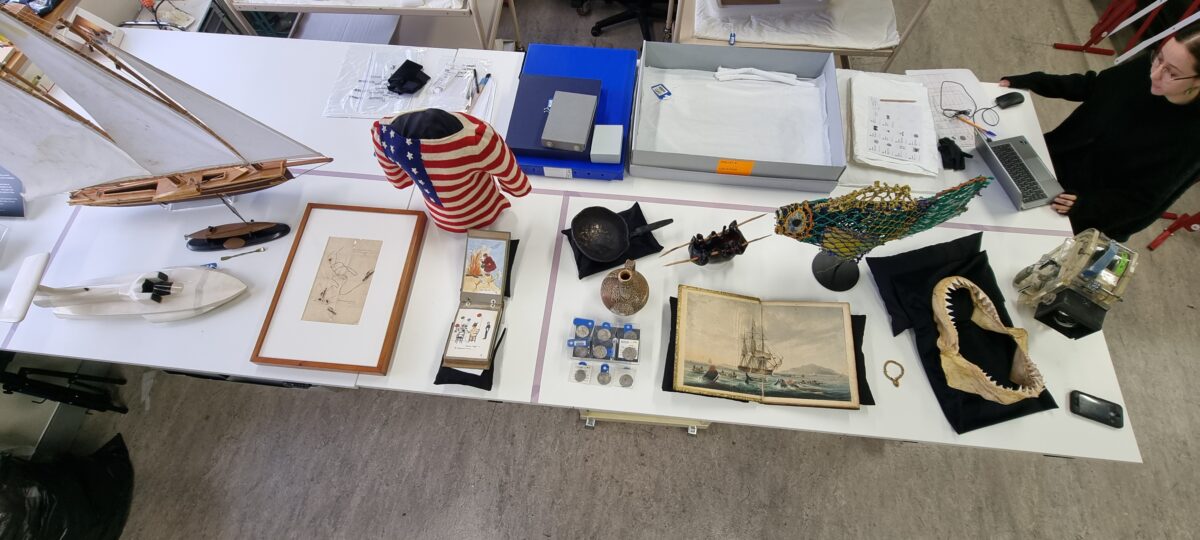
Emma Hayles with items chosen for the National Cabinet Showcase.
On 22 March, Parliament House held a one-day showcase of objects from all the national institutions. Preparing the items for travel and exhibition has been Emma Hayles’ most recent job. Chosen as a way to highlight the key areas of the Museum’s acquisition policy and interest, the items are varied and proved challenging to pack.
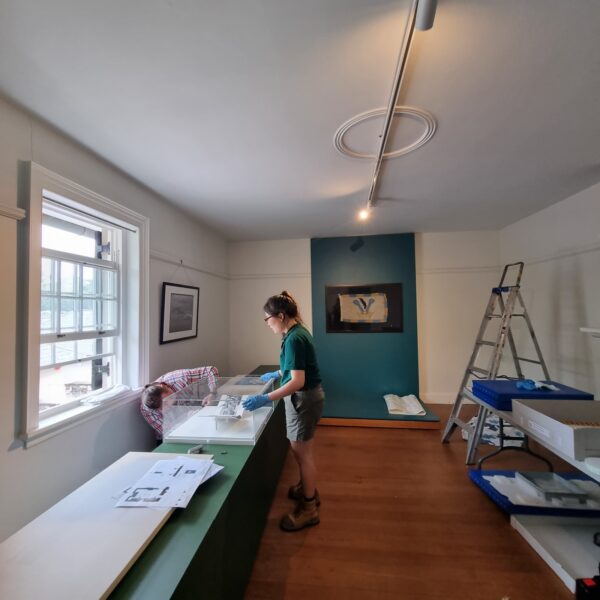
Registrars Judy Kim and Cameron McLean installing one of the items at Old Government House.
Emma treated, made mounts for and, along with registrars Judy Kim and Cameron McLean, travelled to Old Government House in Paramatta to install a collection of works as part of ANMM’s Outgoing Loans Program. The objects, which relate to the Parramatta River, will form part of an exhibition entitled The River: Burramatta to Cockatoo, opening 4 March until 26 November, with the aim of encouraging visitors to explore the history of the Parramatta River, hear stories of centuries of use and learn of the current clean-up campaign to restore recreational swimming.
Events
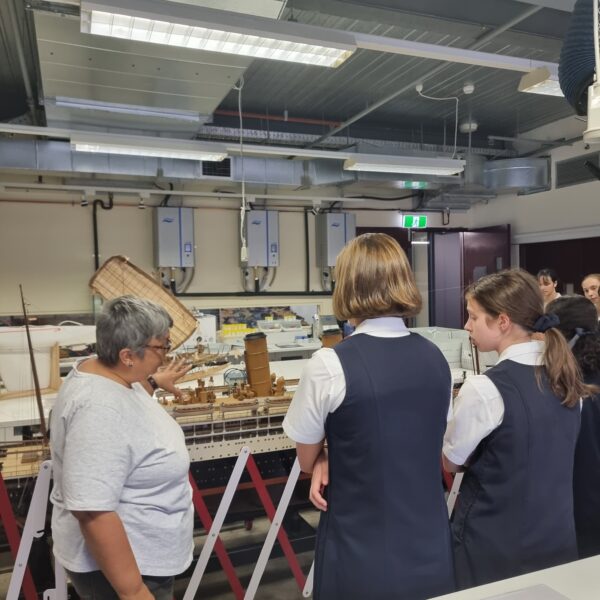
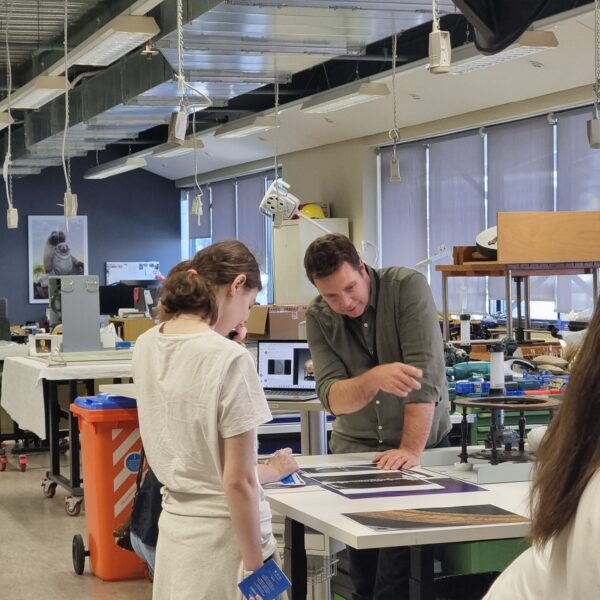
Nick and Alayne talking about some of the treatments happening within the lab.
The Museum held a Women in STEM event on 9 March. Agata Rostek-Robak, along with 14 other speakers, presented to over 400 years 9, 10 and 11 students in the theatre, and the team was involved in behind-the-scenes tours through the laboratory. It was great to see so many young women interested in what was happening.
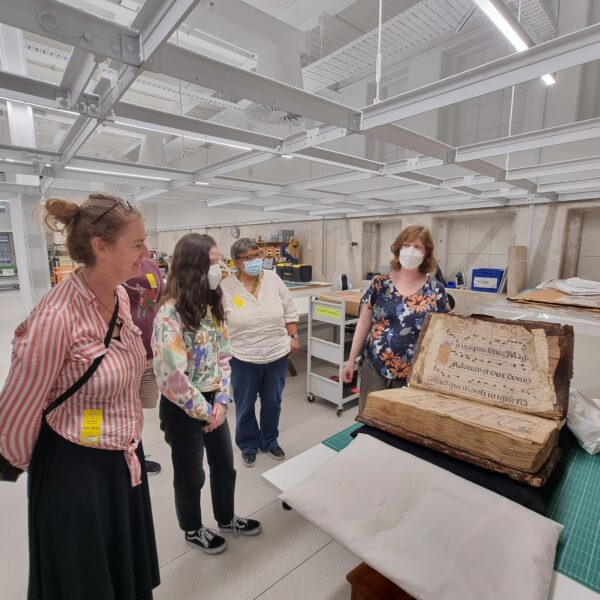
Alayne and interns Camilla and Victoria with Felicity Corkill from the State Library of NSW.
In December of 2022, the conservation team was lucky enough to get a behind-the-scenes tour – and then drinks at the bar – of the State Library of NSW. It was fascinating to see the work being undertaken, the lab and the equipment used, and we thank the team for accommodating us!
International Conservation Services (ICS) New South Wales
Paintings
This last month saw the final 70 paintings from the Lismore Regional Gallery packed up from the Registrar-General’s Building in Sydney where they underwent treatment by the ICS team, and prepared for their shipment back to Lismore. It was an emotional affair as 11 months working in the building, led by conservator Suati Rojas, came to an end. The remaining challenging artworks are now being treated in the lab. The whole of the ICS team feels honoured to be part of ensuring the Lismore collection will continue for future generations.
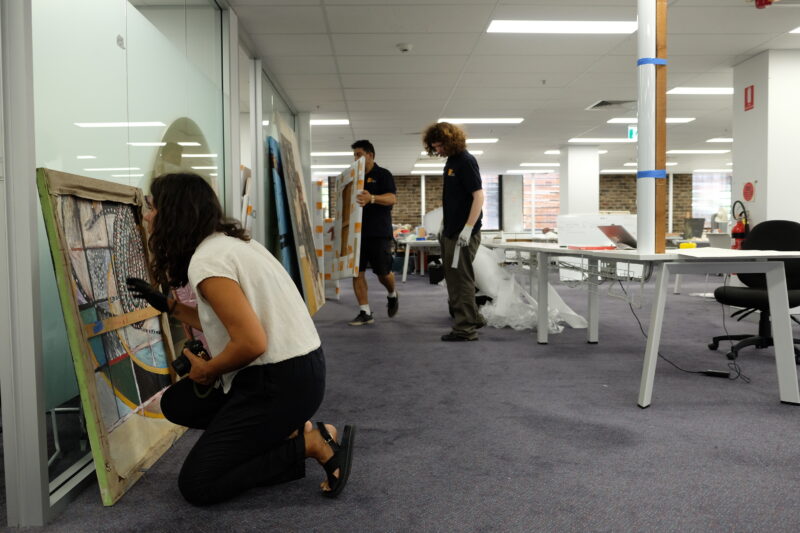
Bianca Goncalves working in the Registrar-General’s Building.
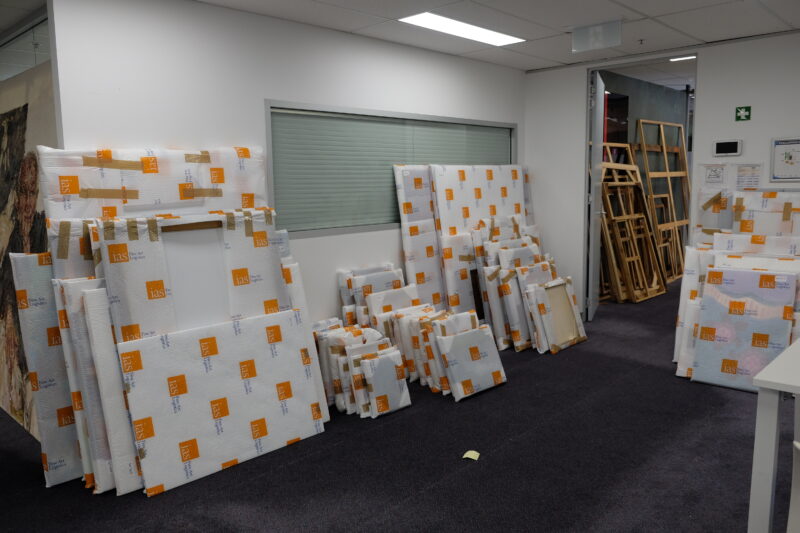
The Lismore Regional Gallery paintings are packed up from Sydney for their big return.
Textiles
The ICS Textiles Team started the year by hanging a vast tapestry at the new Walker Building in Parramatta Square. Woven at the Australian Tapestry Workshops (ATW) in Melbourne and measuring 6m by 11m, it took two spider cranes, two conservators – Christina Ritschel and Alis Jitarescu – three helpers and the watchful eye of Julian Bickersteth CEO, together with Antonia Syme, Director of the ATW, and the original artist, Chris Kenyon, to get the two sections hanging. The installation took years of planning but the result is absolutely stunning.
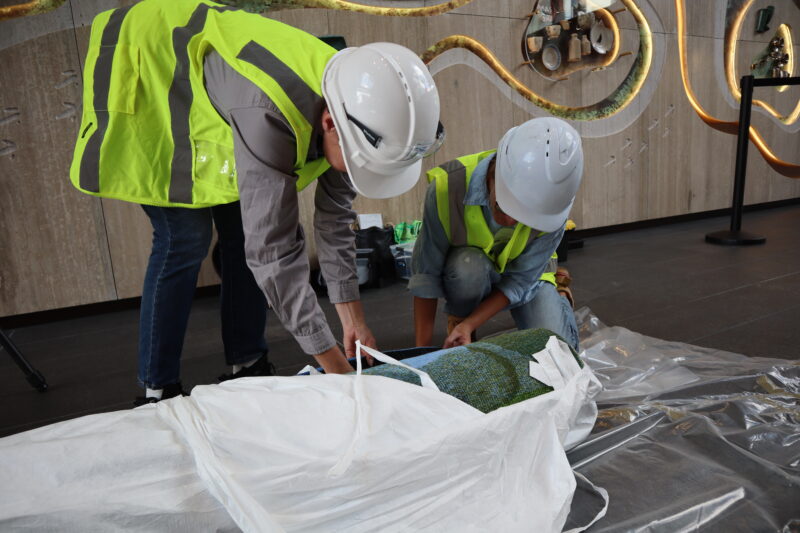
Christina Ritschel and Alis Jitarescu inspecting the tapestry before hanging.
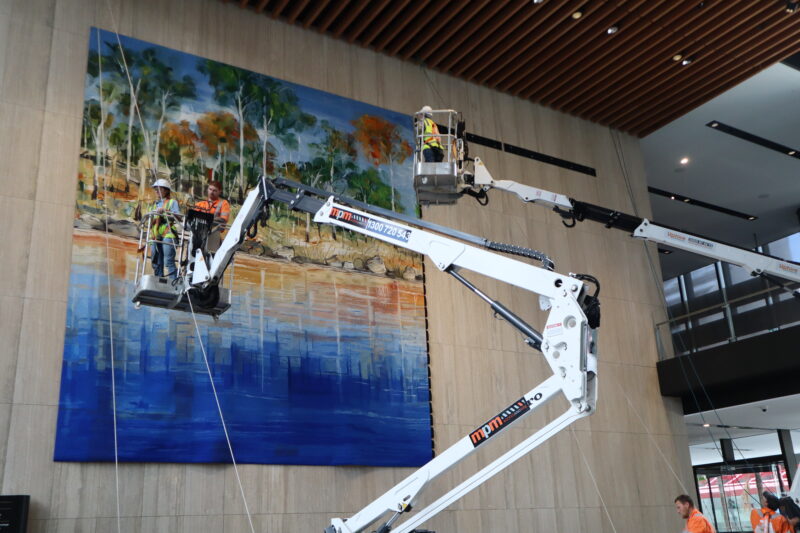
Half the tapestry is hung with the help of spider cranes.
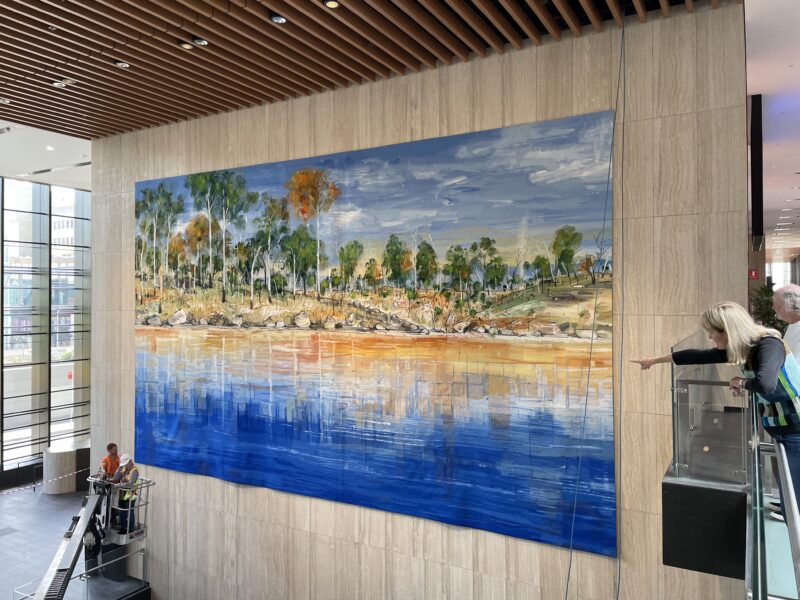
Antonia Syme and Chris Kenyon inspecting the final hung tapestry.
Yolanda El Khouri, Bella Taylor and Shima Gholami also worked to complete the stabilisation of a large World War I flag with embroidered inscription and mounted it in preparation for framing.
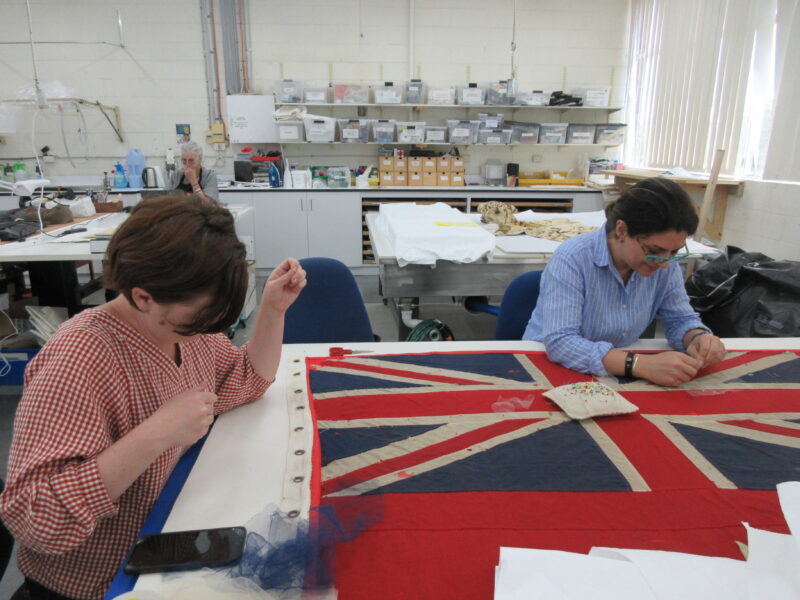
Bella Taylor and Shima Gholami working on the flag.

The embroidered flag arranged on a backing board.
Objects and Outdoor Heritage
Padded cell at the ‘The Lock-up’
ICS has been engaged in some very interesting projects so far this year, including restoring a padded cell for the Newcastle Historic Reserve Trust. This cell is in an 1800s police station that has been repurposed into a contemporary art space, called The Lock-up. ICS conservators Amy Walsh and Isabelle Legg undertook a treatment on the cell, which involved cleaning and mould remediation, and brushing a consolidant over the surface of the original brown leather panels.
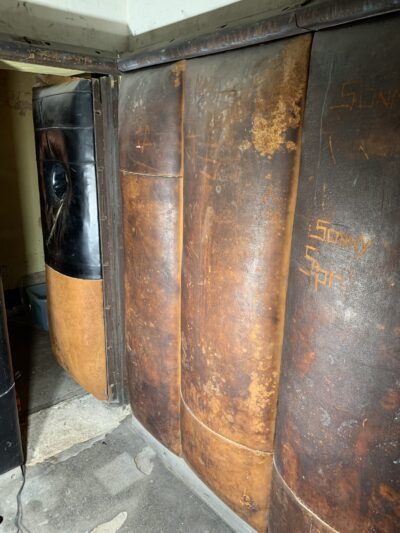
Before treatment—left side wall. Visible mould on upper panels.

After treatment—left side wall. Leather cleaned and consolidated.
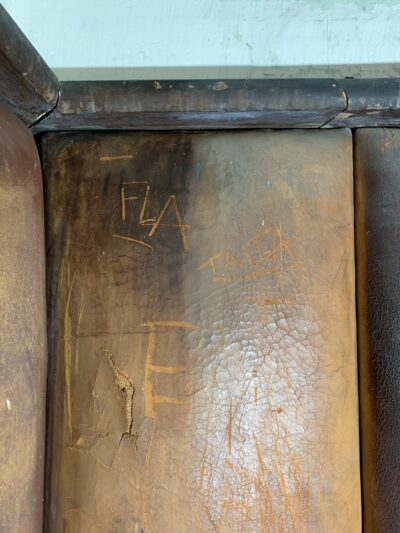
Left side has been cleaned, while right side shows dust and mould.

Isabelle Legg applying consolidant to the panels.
Chinese figures
ICS was engaged by a client to work on two Chinese figures, both of which had suffered breakages. The conservation treatment included cleaning and consolidating broken edges, adhering fragments into place, filling areas of loss with an acrylic spackle filler tinted to match the colour of the original clay, and retouching fills to match the surrounding surface to create a cohesive repair.
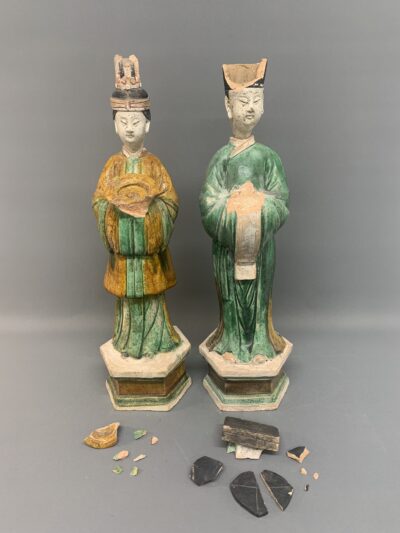
Figures before treatment.

Figures after treatment.
Archaeological mortar
ICS was asked to assist with stabilising archaeological brickwork on a colonial site in Parramatta. Small wasp burrows, holes of 3–6mm in diameter, were evident in several areas of soft mortar, leaving the mortar weak and at risk of crumbling or falling away from the brickwork entirely. Our conservators helped to stabilise the brickwork by infilling these holes.
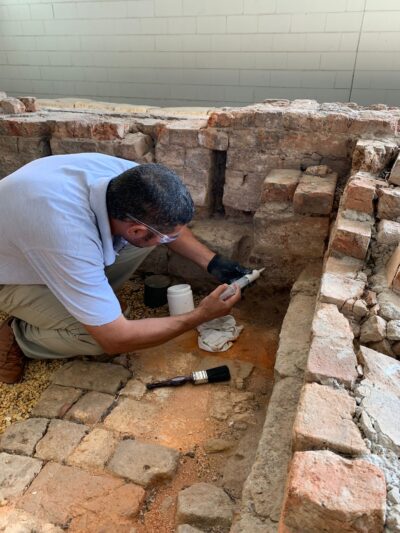
Shrief Eissa on site infilling wasp holes.
Paper
The Paper Team in Sydney has been hard at work over the last few months helping with the many paper items damaged in the Lismore floods. This has entailed lots of washing and stain reduction.
The team has also been onsite assessing many artworks at Macquarie University, helping to prevent mould and water damage.
And creating lots of excitement in the Paper Lab is a recent studio upgrade with the addition of new large tables, with a big increase in storage capacity provided by pull-out drawer storage. Result is lots of happy conservators.
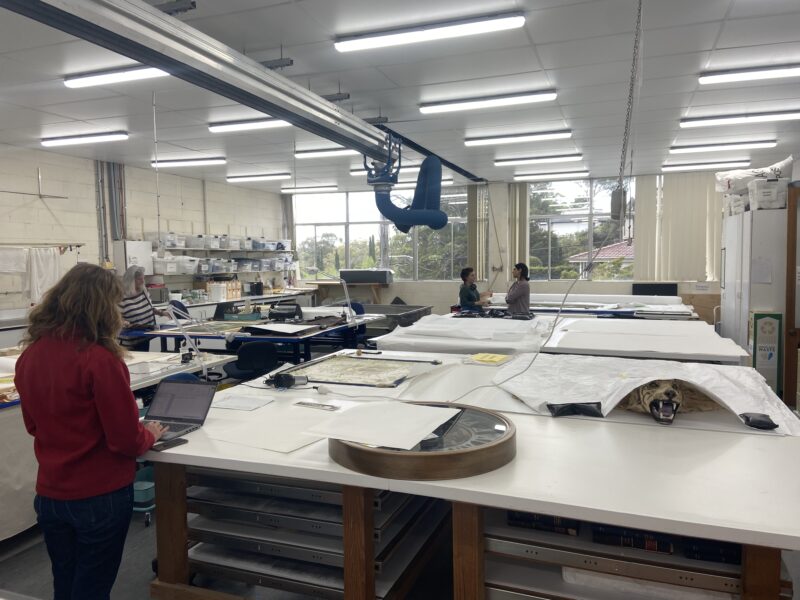
The upgraded Paper Studio at ICS Sydney, Chatswood.
Frames and Furniture
Over the last few months, the Frames and Furniture Team has been busy on projects ranging from cleaning fire-damaged gilding to frame replacements for large, flood-damaged artworks. Mark Searle undertook a major treatment in early 2023 on the structural and surface stabilisation of a 17th century Italian Baroque bookcase. This was suffering from severe historic insect damage and widespread flaking of gilding.
Meanwhile, Elric Ringstad has worked on the mounting and construction of a frame for a monumental 3.5m by 1.5m World War I flag. This required the addition of a subframe and carefully engineered considerations given the flag was to be displayed in portrait format behind a heavy piece of acrylic.
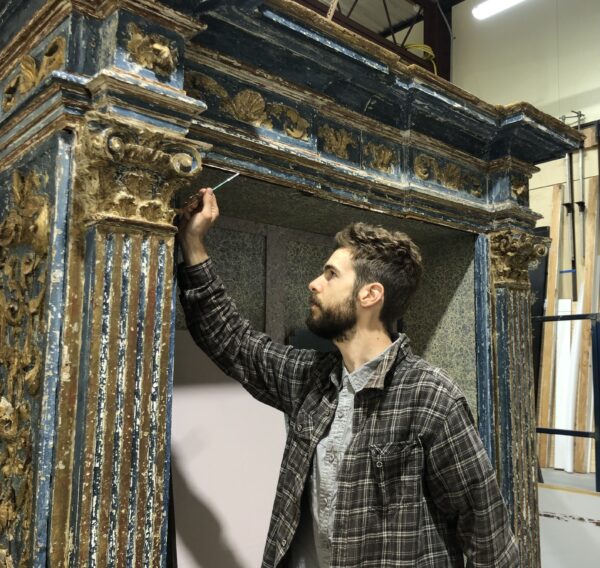
Mark Searle working on the 17th century Italian Baroque bookcase.
Museums of History NSW
The Museums of History NSW came into being on 1 January 2023. This new institution brings together Sydney Living Museums and the NSW State Archives. Collections Care now covers a broad gamut of activity, from the conservation treatment of large paper and photographic collections to mould remediation in house museums, to emptying entire historic terrace houses of their collections to enable crucial capital works to be undertaken. In this issue, we bring a more detailed update on activities at the Western Sydney Record Centre.
State Archives Collection
Tristan Congreve has been working on a pilot project, assessing and treating the R301 series of State Rail Authority plans. The series comprises various material types and formats depicting railway buildings such as station platforms with elevations, sections, and details. In the early 2000s, there was a staged transfer of State Rail Authority Archives to the State Archives collection within Museums of History NSW and, unfortunately, prior to transfer the plans were rolled in batches, with each roll containing plans of varying physical condition. Due to the high interest and request rate from the public, the pilot project was developed to flatten and rehouse for ease of access and retrieval. The pilot is focusing on the first consignment, consisting of around 3200 individual plans. The rolls are processed by identifying stability, material type, and format. Due to the limited scope of the pilot, passive flattening is being trialled with the plans being rehoused in their appropriate drawers. Those considered too unstable for immediate rehousing are treated with conventional methodology before being rehoused. Part of this project is the administrative aspect, which involves barcoding each individual plan and updating details such as titles, numbers and dates to further help the identification processes.
Karina Lavings has been leading a team of five conservators (Jacinta Sanders, Felise Reakes, Bindiya Kumar, Wajeeda Tabassum and Simone Dowd) working on a large-scale preservation project treating Deposited Plans from Land and Property Information. In order to maintain a high treatment output, the team has been utilising various repair tissues. They are currently preparing nanocellulose films with 5% Klucel G in ethanol for a fast and reversible repair method for tracing paper plans. Although the films are slow drying, they’ve found that once the films are prepared it is a very efficient material for repairs on transparent supports. For starched linen plans, photostats and other plans where minimal introduction of moisture is preferable, the team has been preparing re-moistenable tissue made of methyl cellulose and starch paste applied onto 5gsm Tengucho. When plans contain iron gall ink, gelatine re-moistenable tissue, prepared during a workshop Cecilia Harvey from SLNSW conducted whilst on secondment at the archives, is being used.
One Conservation (NSW/VIC)
The year 2023 has kicked off with lots of work and lots of travel for the folks at One Conservation. It’s a good thing we love to do both!
In early February, we spent time on site at the Herberton Mining Centre and Great Northern Mine site in Herberton in the Tablelands Region of Far North Queensland. This former tin mine is recognised for its role in the development of the mining industry in the Atherton Tableland and its significant collection of mining machinery. The centre is a recipient of an NLA Community Heritage Grant and we are preparing a PNA focusing on its rare and significant outdoor collection.
Another recent highlight was working at the Norman Lindsay Gallery in the Blue Mountains to clean and carry out some repairs on several ship models from the display. We had a great day working in the gallery with a lovely group of skilled and dedicated National Trust volunteers—many hands made light work! This project was also funded by an NLA Community Heritage Grant. Karina Acton was also at the Mawson’s Hut Replica Museum in Hobart last month for the final wrap up of the 2021–22 Antarctic expedition in which she was involved for the Mawson’s Hut Foundation.
Meanwhile, in Sydney, we’ve had the pleasure of doing the conservation and installation for the new Sydney Roosters museum, the Foundation Room in the club’s home, the Nick Politis Centre of Excellence. This involved the preparation and dressing of mannequins (including bespoke Dacron deltoid and pectoral muscles!), custom hat mounts plus a mount for the Roosters’ mascot head. This was a fabulous project and a really unique collection that we are proud to be associated with.

The Nick Politis Centre of Excellence. Image credit: Suzanne Pontey.
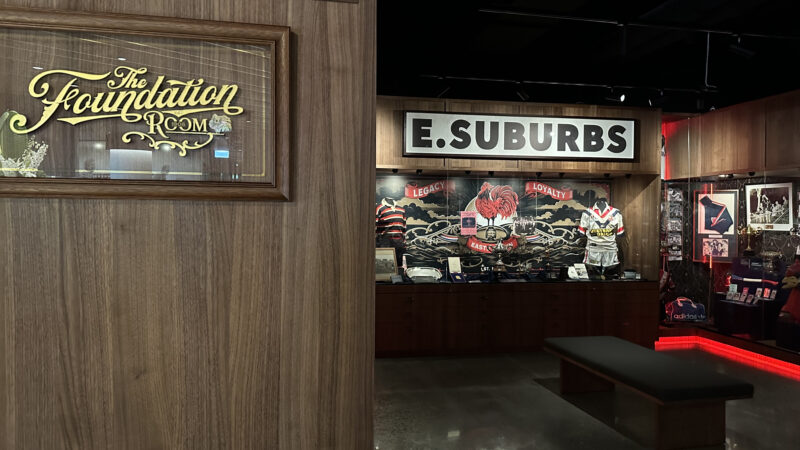
The Foundation Room. The Nick Politis Centre of Excellence. Image credit: Suzanne Pontey.
In Melbourne, we’ve recently done some work for a private school in Toorak, including cleaning and waxing a number of bronze plaques and statues. We’re also continuing with a new project for Monash University Library and are underway with the conservation of another significant archaeological assemblage from Victoria.
O’Sullivan Conservation
What a change four months can bring. We have had two additional assistant objects conservators, Emma and Camilla, and two conservation technicians, Thomas and Anna, join the team for a 10-week conservation cleaning project, and hopefully other projects in the future. Additionally, we welcomed Katherine Rosenthal into a senior conservator and administrator role, primarily assisting Hannah with contract and project management and supporting the conservators in the workshop as required. Despite showing great talent, Nix decided that conservation was not for them and resigned in January to seek other opportunities. This takes the team to a total of eight staff and solidifies O’Sullivan Conservation’s position in the industry as a growth firm, and one that is here to stay.
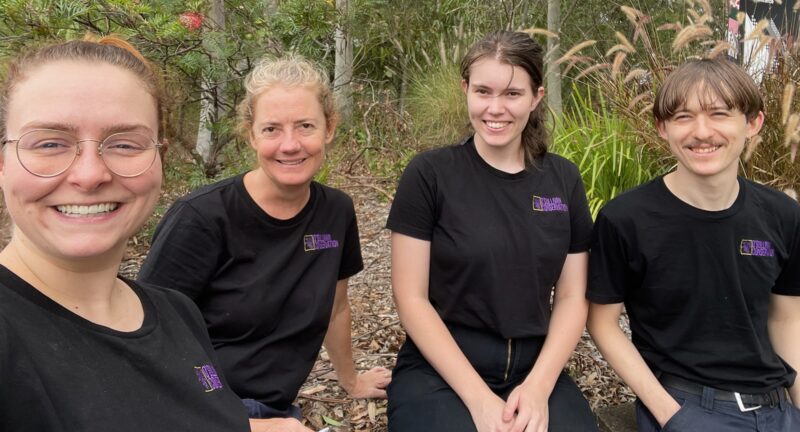
left to right): Emma, Camilla, Anna and Tom, the ‘gun’ conservation cleaning team at O’Sullivan Conservation.
Professional news
O’Sullivan Conservation would like to take this opportunity to congratulate Emily on completing her Master of Cultural Materials Conservation degree at Melbourne University and receiving her final marks, seeing her graduate with first-class honours. She is looking forward to her graduation ceremony in August this year.
Treatment projects
It was a great privilege for the team to be invited to attend the official opening of the Archibald Fountain by the City of Sydney in March, alongside other principal contractors, with Clover Moore posting about the project the following day.
O’Sullivan Conservation was engaged by the City of Sydney to undertake quality control of the bronze conservation works associated with the Archibald Fountain. This included reviewing and approving the proposed methodology and products used by the contractor completing the conservation treatment, attending the site throughout the project, and reviewing the final conservation treatment report, to ensure that each stage of the work was carried out to industry standard.
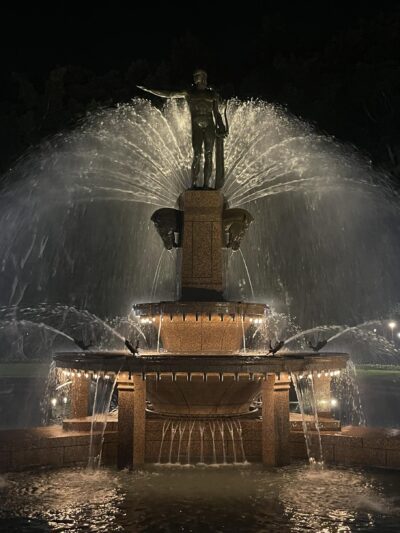
Robert Woodward’s 1960s lighting design, newly installed, shows the Archibald Fountain in the best light.

Archibald Fountain official opening: Eoin, Hannah, and Emily enjoy a drink with the other invitees prior to Clover Moore’s official ribbon-cutting ceremony.
The major conservation treatment of the Sir Leslie Morshead Memorial Fountain at the Royal Botanic Garden, Sydney, is now complete. This project included major conservation repairs to the copper alloy shrouds, waterproofing and retiling of the basin, and installation of custom-made grates over the drains.
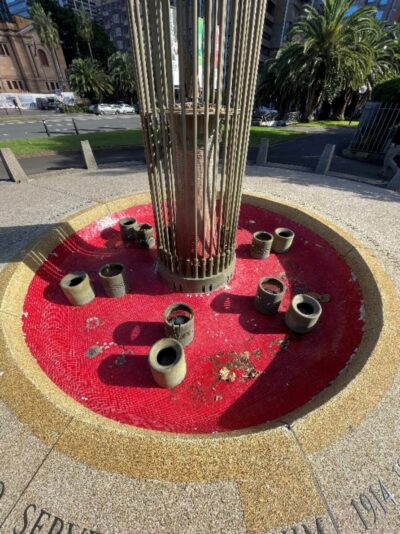
The Sir Leslie Morshead Memorial Fountain before treatment, showing the state of the tiles and copper alloy components.
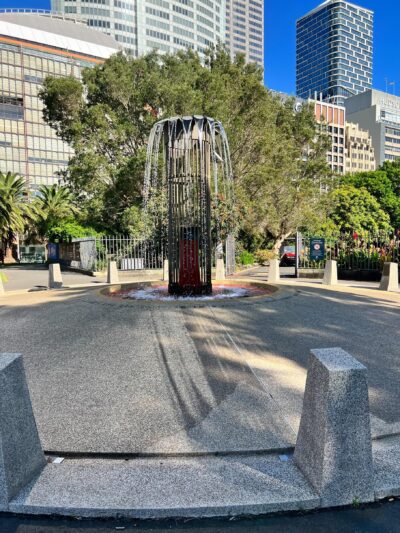
The Sir Leslie Morshead Memorial Fountain after treatment, with the water running again.
O’Sullivan Conservation continues to demonstrate its ability to service client requirements, with the rapid recruitment and training of four new staff to support a 10-week conservation cleaning project. Hannah recruited and trained the team with three weeks’ notice, delivering comprehensive training at the workshop prior to attendance at site. Emily has continued the team’s training throughout the project, with Hannah’s support.
The conservation cleaning theme continued in February, with Eoin, Emily and Hannah heading to Canberra to undertake the conservation cleaning of a heritage skylight at the National Film and Sound Archive (NFSA), Acton Building library. Luckily the weather was relatively mild and sunny for the first half of the project, with the team working at roof level to clean the exterior of the skylight.
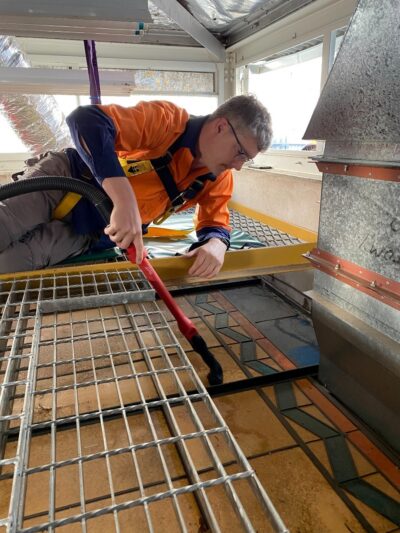
Eoin brush vacuuming the heritage skylight at NFSA.
State Library of New South Wales
Staff changes
In February 2023, Conservator Nikki Purkiss commenced parental leave as she and her partner have become parents to twin boys.
Senior Conservator Felicity Corkill also commenced parental leave in February following the birth of her and her husband’s son Harry. In Felicity’s absence we welcome Abigail Hundley on secondment from Museums of History NSW into the role of Senior Conservator, Books Objects Paintings.
On a happy note for her, but a very sad note for us, Senior Conservator Nichola Parshall will be saying farewell to the Library after 34 years on Thursday 6 April 2023. Nichola’s contribution to the work of the Branch and the Library has been immense and we will miss her very much.
Professional news
Registration
In January, the Library became an approved borrowing institution under the Federal Government’s Protection of Cultural Objects on Loan Scheme. This was to satisfy the loan requirements for international loans for two projects later this year. We were the 13th approved institution, and the second library to gain approval. The project was led by the Library’s Registrars, Caroline Lorentz and Lauren Dalla, and involved a review of our incoming loans and other collection management policies and procedures, many of which were updated to ensure we met the requirements of the scheme. Further information about the Scheme can be found here
Preservation team
Lang Ngo contributed a chapter on transportation to the new Conservation of Books publication released on 27 March 2023. Online and in person events have been organised by the contributors to complement the publication of this book. Visit here
In March, Phoebe Clarke (assistant conservator) moved from the Storage team to the Preservation team. Phoebe and assistant conservators Silvana Volpato, Nicholas Beckett and Aileen Dean-Raschilla have been busy working with new acquisitions including a huge batch of rare books and artists’ books. We also assisted the Exhibitions and Loans team with the preparation of items for display in the Pride (R)evolution exhibition. The team has also been helping the Storage team with the architectural drawings project, flattening drawings and plans for a collection move.
Our quarantine room has been very busy, and we have all been checking new incoming collections to ensure there are no pest or mould issues.
In treatment news, Silvana completed repairs to an issue of The Moruya Advocate newspaper, which had been requested for conservation before digitisation pre-COVID. Silvana and Lang Ngo finally completed a lining of the last brittle folio in January.
As Nikki Purkiss is on leave, all members of the team have ably stepped up and are continuing to monitor the Library’s display and collection environment and update our disaster store and kits, which was much needed after the two-plus years of La Nina floods and wet weather.
Lang Ngo has been training staff in collection handling and freezer access, and is also developing online disaster awareness training for new staff using the Library’s online Learning and Performance system. It looks very promising so far and will make capturing all staff a much easier process.
Exhibitions and Loans team
Helen, Cathryn and Jochen in the Exhibitions and Loans team have been assessing and coordinating the preparation of content for the new Photographic Gallery, which is scheduled for opening in July 2023. The gallery is being developed as part of a larger build, which includes a 300+ seat auditorium. In addition, the team led the conservation, preparation, and installation of items for the critically acclaimed Pride (R)evolution exhibition, which opened in time for World Pride and the Sydney Gay and Lesbian Mardi Gras. With the 400th anniversary of the birth of Shakespeare coming up soon, the team is busy assessing and preparing items for a new exhibition in July this year.
Paper and Photographic team
The Paper team is delighted to welcome Hoa Huynh, who has joined the team whilst Kate Hughes is on secondment to the AGNSW. Hoa has been developing her skills on high-priority watercolours from the new acquisition of works by Anna Collard made in the Lake Macquarie area during the 1840s. Due to the number of works in the acquisition, all members of the Paper team have been working on their treatment. In addition, Hoa, Wendy Richards and Cecilia Harvey have been working with Nichola Parshall on refining the mounting system for the 27 mammoth Holtermann glass plate negatives to be displayed in the newly constructed Photographic Gallery. The glass plates, a panorama of Sydney Harbour from 1875, pose a challenge due to their size and fragility, as well as the selected display system, which showcases them in a vertical orientation.
Dana Kahabka has been treating some John Rae panoramas (with Hoa) to complete the suite of his works exhibited at the end of the Grand Vistas display. Treatment has involved removal of canvas linings and multiple backings as well as suction-table washing before repair and retouching. With all the Rae panoramas, additional drawings and watercolours on the reverse have been revealed through treatment—an added pleasure for conservator and curator alike. Dana has also been researching the Mary Reibey journal, another high-priority item, to commence a condition report and treatment proposal.
Guy Caron has used the Miniature survey to inform his work on the cased items in this collection. He has been delicately repairing hinges and reconstructing missing parts of cases to enable the miniatures to safely rest back in their original housings. To date, Guy has completed work on 102 cases. In addition, he has been working through the 12 photographic albums selected for the new Photographic Gallery. Wendy Richards is the Paper lead for Charles Rodius – Portraits of a Colony, for which her work has involved the assessment of material in relation to treatment and the completion of backing removals, minor repairs and sympathetic retouching. Although many of these small works have had a hard life in the past, they showcase the skill in ‘trois crayons’ of this French artist.
Cecilia Harvey has been working through treatments for the Photographic Gallery, which have been as diverse as the Frank Fahey scrapbook of glamorous B/W silver gelatin 1920’s and 30’s mug shots, to the oversized Lindt carbon print of PNG. For the latter, Cecilia has also devised a safe mounting system to enable the work to be displayed vertically in an acrylic vitrine.
Trish Leen has been working on a small but delightful Arthur Streeton watercolour and, for a change of pace, also treating 1840’s Tasmanian convict lists. During her work on the convict lists, Trish found a watermark and after a quick search of our catalogue found the Sketches made aboard H.M.S. Rattlesnake by Oswald Brierly, compiled by Owen Stanley, circa 1848, which bear the same watermark, identifying the paper’s maker and age.
International Conservation Services (ICS) Queensland
In February, Doug Rogan from our Canberra office and Mei Wilkinson were joined by specialist aircraft consultant David Crotty for a week in Longreach, Queensland, where they visited the Qantas Founders Museum (QFM) to assess five highly significant planes. ICS has been commissioned by QFM to develop conservation management plans to guide the long-term conservation and display of the planes, and we’re currently working through our on-site findings and drafting the documents. The five planes in question are:
- Boeing 747-238B VH-EBQ
- Boeing 707-138 VH-XBA
- Douglas Aircraft Company DC3 VH-EAP
- Catalina PBY-6A
- Lockheed 1049 Super Constellation.
There is more information available at the QFM website
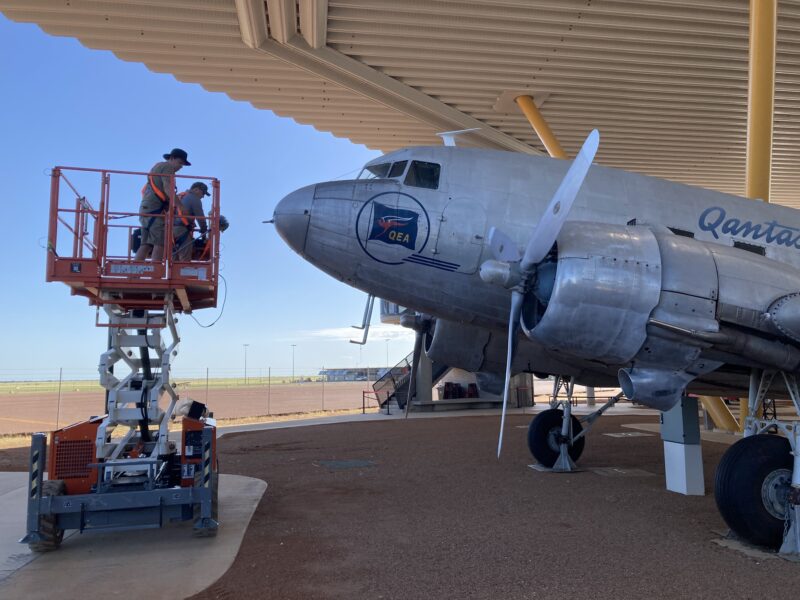
Douglas Aircraft Company DC3 VH-EAP.
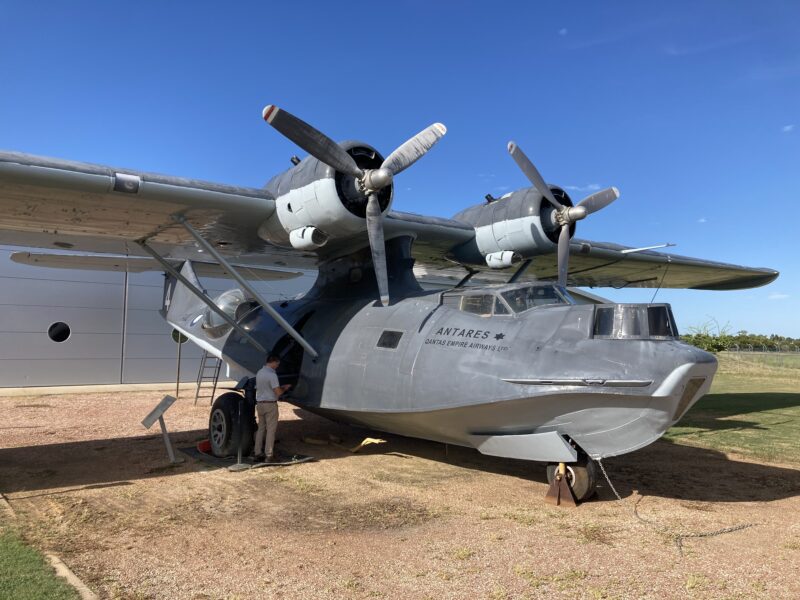
Catalina PBY-6A.
Queensland Museum
The past year has been very busy for the conservation team at Queensland Museum (QM), with new staff and familiar faces contributing to the multitude of projects and exhibitions that have come our way.
Sue Valis, our conservator at the Museum of Tropical Queensland, continues the desalination treatment of the HMS Mermaid anchor, which she has been treating since 2019. Over the past year, Sue has actively worked with the Museum Development Officer to engage with small communities across Queensland on numerous projects.*
Our Senior Conservator, Cathy ter Bogt, will be the public face of our team for this year’s World Science Festival, giving a floor talk to our visitors about the wonders (and potential perils) of metal polishing. Cathy recently met with the Laura Rangers from Far North Queensland, who were given a tour of the Museum’s back-of-house facilities. The visit sparked insightful conversations about the influence of community wishes and practices on the conservation and exhibition of cultural objects. Cathy is currently preparing to write a thorough condition assessment on the QM’s FP & AP Dodd Collection of Tropical Insects from Australia and New Guinea. The specimens were collected by FP and AP Dodd from 1917 to the 1960s, and were artfully arranged to create striking visual effects through the specimens’ natural pigmentations, patterns, and unique anatomical features.
Jenny Blakely has been going through QM’s ‘iconic’ objects, checking their current condition and assessing storage. Jenny very recently assessed a number of fossils and fossil replicas in preparation for the Dinosaurs of Patagonia exhibition, which opened on 17 March. A two-second shot of her hand-brushing a fossil was even featured on 7NEWS! Jenny has also been treating and re-housing several Fijian objects, including a model canoe, a plant-fibre mat and multiple sets of arrows, in preparation for a curatorial research project.
Textile Conservator, Solitaire Osei, has been busy conserving a collection of garments by Mark Wilson (‘Hairy Dog’) and preparing the garments for photography. This has involved cleaning, humidification, and minor repairs. The mannequins on which they were photographed required extensive preparation to ensure the garments looked their best. Solitaire has also been working on an audit of the conservation lab’s chemicals, making sure our Materials Safety Data Sheets and chemicals register are up to date.
Paul Coleman is our new Preventive Conservator, joining QM early this year and working primarily on a major mould-remediation project at the Museum’s offsite storage facility. He is also assessing the environmental conditions at QM’s regional campuses. Paul’s position is brand new, and reflects the importance of indirect but strategic measures in preserving collections, particularly those as large and diverse as QM’s.
Gab Garde joined the team last year, working two days a week as Assistant Conservator, and three days a week at the University of Queensland’s Integrated Pathology Learning Centre as Curatorial Assistant and Conservator. Most recently, he has been working on treating metal objects for the Spencer Project, an upcoming exhibition at the Workshops and Rail Museum. As a recent graduate, Gab’s first foray into tannic acid treatments has been an exercise in perseverance, with a corroded wheel rim receiving no fewer than 15 coats of tannic acid solution before going on display.
Every Monday, our Technical Assistant, Bridget Kinnear, diligently cleans the Museum’s showcases and plinths, continually organises our conservation lab, and re-houses objects. Bridget keeps a watchful eye over the gallery spaces, alerting the conservators to signs of visitor interaction, possible object deterioration, or evidence of off-gassing inside showcases.
Paper Conservators Caroline O’Rorke and Amelia O’Donnell have been contracted to assess and treat QM’s highly significant collection of 128 watercolour and gouache artworks by Ellis Rowan. Caroline and Amelia have assessed all of the works, and have chosen 30 out of the 128 for an upcoming loan. These works were considered the most stable, and most relevant to the loan region. Ellis Rowan’s works often have inherent issues due to materials used, compounded by long display times. These issues include fading of medium, darkening of paper stock, and instability of gouache, especially when gum Arabic has been applied. The works are having minor treatment, new mounts and frames, and condition reports. Ongoing considerations include transporting the works, and how best to do this to prevent further damage to the pigments.
[*Paragraph about Sue Valis adapted from internal newsletter authored by Cathy ter Bogt and Ewen McPhee.]International Conservation Services (ICS) South Australia
Thebarton Hall (former West End Brewery site)
We had the pleasure of working as part of the project team that included Lion, McMahon Services Australia, and archaeologist Guadalupe Cincunegui to conserve the state-significant archaeological remains of Col Light’s House at the former West End Brewery site in Thebarton, SA. The subsoil remains of the house, the stables, a cellar, a well and the garden layout were all amazingly well preserved under the slab of a warehouse for nearly a century.
We carefully placed geotextile sandbags over the incredibly fragile brick remains before covering the entire area with a further layer of geotextile fabric and finally a generous layer of clean washed sand. The ruins are now safe and can easily be re-exposed and interpreted once the future of the site is determined.
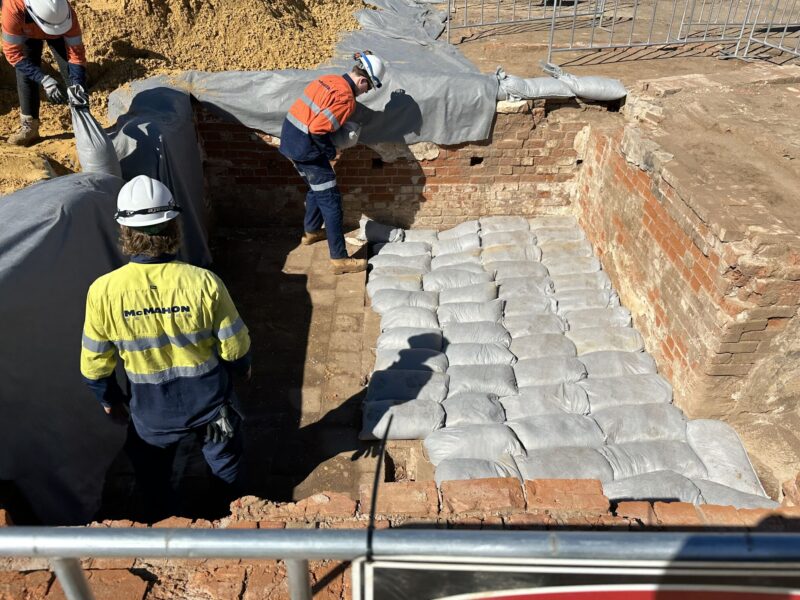
Carefully placing geotextile sandbags over the incredibly fragile brick remains.
Amy Bartlett Artist, Conservation and Curatorial Services
Over the past few years, Amy Bartlett has expanded her private conservation business to include a range of collection and exhibition related roles.
Amy is dedicated to local arts community groups in Tasmania. She has curated and managed many community exhibitions at venues including Sawtooth ARI Gallery, Queen Victoria Museum and Art Gallery, Launceston Library, and the Hobart Library.
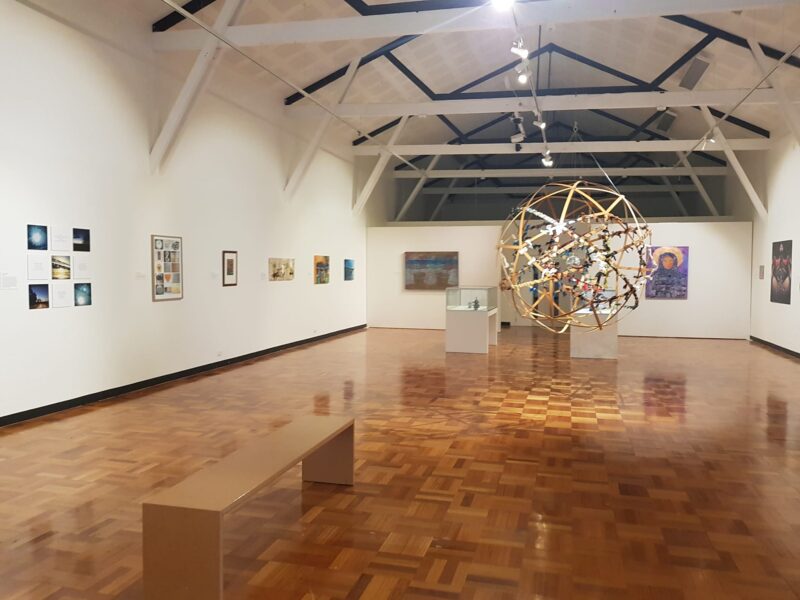
Grounded: Place is Space exhibition at the Queen Victoria Museum and Art Gallery (2022). Image credit: Amy Bartlett.
Conservation projects include insurance assessments following devasting floods and arson fires in libraries around Tasmania. These assessments include making recommendations for the insurance companies while working with staff who have dedicated part of their careers to caring for the damaged collections.
Amy has also carried out many mould remediation treatments to artworks and photographs following damage caused by flooding in private residences and institutions.
Other assessments include conservation reports for in-situ wallpaper and other paper collections at some of the Australian Convict Sites.
In addition to her private business, Amy is also Collections Manager at a new art museum, dAda mUse, opening to the public in Launceston, Tasmania, in April 2023.
Tasmanian Museum and Art Gallery (TMAG)
The conservation team has been busy putting together the exhibition Behind the Layers: Authenticating the Stories of Paintings curated by Jenny O’Connell, Senior Painting Conservator. The exhibition features treatments on 19th-century oil paintings and their frames, a showcase of geological specimens and pigments, and short films on painting and frames treatments by Jenny and Lisa Charleston, Conservation Technician. The exhibition features a portrait mid-treatment to demonstrate the difference varnish removal and overpaint removal can make to a painting. Information regarding the exhibition, as well as a link to the videos, is available online.
Cobus van Breda, Senior Paper Conservator, and Michelle Berry, Senior Object Conservator, prepared a dress for loan to the Allport Library and Museum of Fine Arts. The dress required both sets of conservation expertise as it features paper and textiles. The dress is part of the exhibition Fancy Dress: From tutus to cosplay.
In other news, Nikki King Smith recently retired from her role as Senior Object Conservator. Nikki worked at TMAG for a number of years, seeing the organisation through the redevelopment and moving of collections to a new storage site, and finishing up with the introduction of anoxic showcases to the museum displays, providing safe housing to some of the thylacine specimens. Nikki has been making the most of her retirement, with her boat that she restored being featured in the recent Wooden Boat Festival in Hobart. We wish Nikki all the best with her new adventures.

Behind the Layers exhibition at the Tasmanian Museum and Art Gallery (TMAG), 2023. Image credit: Jenny O’Connell.
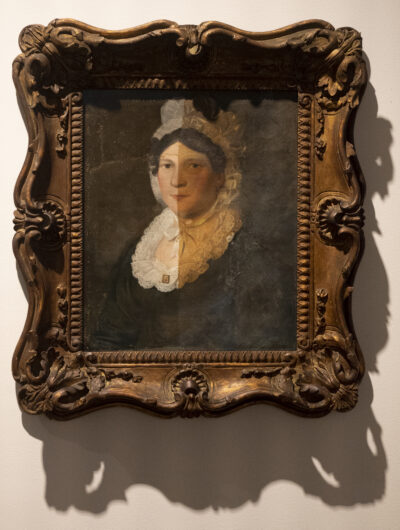
Attributed to Henry Mundy, Portrait of Sarah White (née Gore), c. 1847, displayed mid-treatment in the Behind the Layers exhibition at TMAG, 9 March 2023. Image credit: Jenny O’Connell.
Extent Heritage
In May 2022, Extent Heritage welcomed Lucy Welsh as Principal Heritage Adviser of Conservation to its growing team of heritage professionals. Lucy specialises in the conservation of archaeological material, objects, and textiles, as well as environmental control and preventive conservation. She is particularly passionate about culturally appropriate conservation techniques.
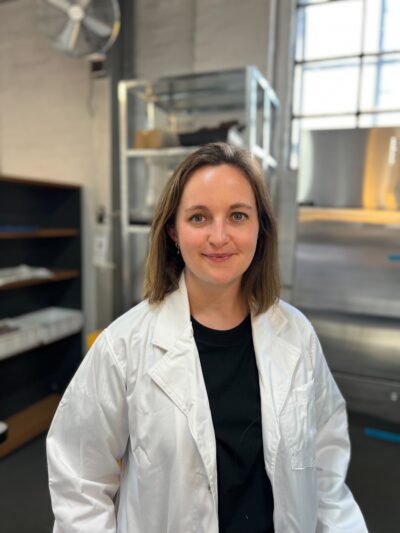
Lucy Welsh, conservator at Extent Heritage.
Lucy has been working hard on the development of an in-house conservation lab to serve the archaeological conservation needs of Melbourne, with an eye to also working on materials from NSW, Queensland and Tasmania.
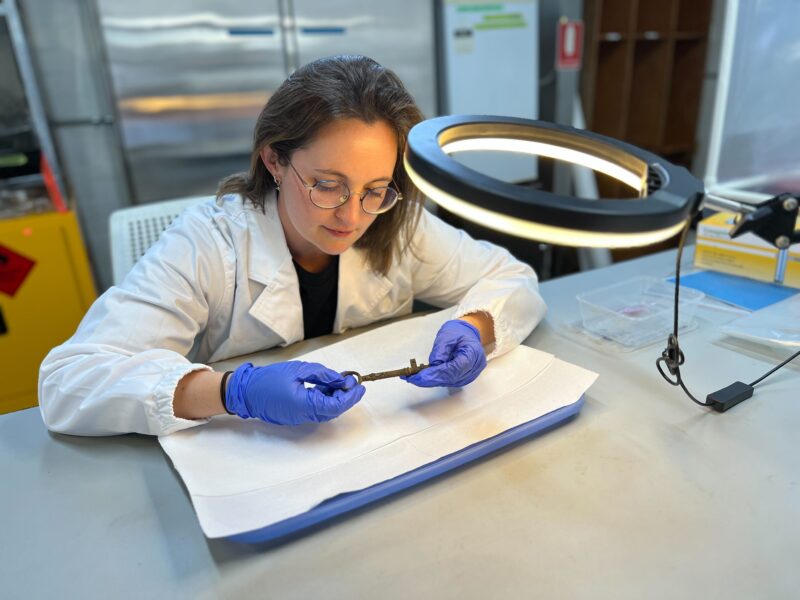
Lucy working on object assessment in the Extent Heritage lab.
Lucy is currently working towards more thorough training of field archaeologists to ensure that conservation of archaeological material is considered before it has left the ground. While the current focus of the Extent Heritage conservation department is on archaeology, the lab will also be servicing non-archaeological material, and will be working with interpretation and exhibitions to help heritage and cultural knowledge reach a broader audience and share the extensive amount of cultural heritage work being undertaken across Victoria.

Lucy undertaking rock-art conservation at Gariwerd in 2019.
Grimwade Centre for Cultural Materials Conservation
The Grimwade Centre welcomed students from Japan, Sweden, mainland China as well as Macau and Hong Kong, the UK, USA, the Philippines, Taiwan and around Australia who commenced their first-year subject Conservation Professional Practice at the end of February. Victorian Branch President Charlotte Walker presented on the AICCM and invited them to join the Institute. We are looking forward to sharing their conservation journey with them!
The Grimwade Centre is pleased to announce that Dr Petronella Nel has been promoted to Level D Associate Professor. We also welcomed our new lab officer, Dr Rose Barrett! Rose joins us from the university’s School of BioSciences. After completing her PhD in botany, she was critical in enabling several major off-campus field subjects in biosciences that drew on aspects of her academic expertise. She has a very good knowledge of a range of scientific procedures and equipment and in her new role Rose will support Grimwade academic staff in laboratory management, procurement and OHS, and provide technical support across our spaces.
In other news, the Grimwade Centre is now offering a second internship subject, Conservation Industry Internship 2. Taken together with the existing compulsory subject Conservation Industry Internship, this elective subject allows students to undertake an extended placement of at least six weeks with a key industry partner. By combining these internship subjects with the Conservation Thesis subject, there is an opportunity for a student to complete a substantial project with an industry host, whether it be a more complex, researched treatment, an assessment of a collection, development of a policy, or other conservation research project.
Yackandandah Museum Fire Project
Conservation students Joshua Loke, Samantha Rogers and Madelyn Fraser are midway through the Fire Project, a collaborative effort between the Grimwade Centre for Cultural Materials Conservation and the Yackandandah & District Historical Society (YDHS). YDHS runs the Yackandandah Museum, a small volunteer-led regional museum. In 2006, a fire devastated the museum’s Bank of Victoria building, and damaged most of its contents. What followed was a concerted community effort to retrieve the collection items they could, and to rebuild the premises. The Fire Project is envisioned to tell the story of the town’s resilience. Through the University of Melbourne’s Willem Snoek Conservation Award, in April 2022, the three students were able to complete a process of accessioning objects salvaged from the fire. As part of this work, they also produced a preservation needs assessment for the museum’s collection store. Further, Josh, Sam and Maddy secured grant funding from the Copland Foundation to assist YDHS in designing an exhibition featuring the salvaged objects, as well as other material related to the tragedy. In October 2022, they completed a series of oral history interviews with members of the Yackandandah community and completed a significance assessment for the 2006 Fire Subcollection. Then, in February this year, a design workshop was conducted to discuss YDHS’s aspirations for the exhibition. The team intends to complete a concept design report in July 2023. The Fire Project is an example of conservation in action in a setting that is often overlooked by traditional funding sources. The team thanks the donors and trustees of the Willem Snoek Conservation Award, as well as the Copland Foundation for enabling this vital work.
Media and arts news
On 13 February, Robyn Sloggett and Marcelle Scott spoke with Jen Hoyer from NewBooksNetwork podcasts in New York about their recent publication Climatic and Environmental Threats to Cultural Heritage (Routledge 2022)
Given her seminal Getty publication Sidney Nolan: The Artist’s Materials, in December Dr Paula Dredge was invited to open the exhibition Expansive Ground, Sidney Nolan in the Wimmera at Horsham Regional Art Gallery. Paula has spent 10 years studying Nolan’s practice and material use and talked about how ‘Nolan is a puzzle; the more you know about Nolan the more questions you have’. Paula’s comments on the exhibition are that it was a lively opening of an exhibition of paintings from the Horsham collection and loan works from Heide Museum of Modern Art and the National Gallery of Australia. The works depicting the Wimmera were painted by Nolan while he was stationed in the area during World War II . Paula travelled out on the road to Dimboola the day following the opening and was struck by how little had changed since Nolan’s time, with the straight flat road running parallel to the rail line and the silos and rail bridges at Dimboola particularly evocative.
The Didar exhibition at Arts West Gallery, University of Melbourne, curated by Dr Sophie Lewincamp, Dr Leila Alhagh, and Dr Sadra Zekrgoo, launched in February 2022 and continued for a year. The exhibition showcased nearly 60 Middle Eastern manuscripts from the Special Collections housed at the Baillieu Library. The exhibition welcomed students, staff and Middle Eastern communities as well as the general public through multiple events held at the location, which included:
- Ink-making workshop for the general public (June 2022)
- Ink-making workshop for Middle Eastern refugees—collaboration with Free to Feed (July 2022)
- Ink-making workshop and demonstration for University of Melbourne Open Day (August 2022)
- Exhibition tour and calligraphy workshop for visiting students from Darul Ulum College Victoria (September 2022)
- DIDAR: Arts of the Persian Court event (September 2022)
- DIDAR: Stories of Middle Eastern Manuscripts public lecture and tour of the exhibition (November 2022)
- Listen to this read: a Persian calligraphy workshop (November 2022)
- Petals and poets: a Turkish cultural workshop (November 2022)
- Curatorial floor talk with Dr Sophie Lewincamp and Dr Leila Alhagh (November–December 2022)
Awards news
The Grimwade Centre’s Dr Jonathan Kemp is one of the chief investigators on an ARC 2023 Discovery Projects Award led by Dr Louise Shewan in Earth Sciences and entitled Megalithic Connections: Imperilled Cultural Heritage in Laos and India. Jonathan will work with colleagues in Laos and India on conservation assessment and training workshops to help preserve innumerable life-size ancient stone jars found in both countries.
We congratulate Diana Tay who was awarded her PhD entitled ‘Building a conservation material record: a study of paintings by Cheong Soo Pieng and Georgette Chen’. Supervisors Nicole Tse and Robyn Sloggett are happy to see Diana open a new studio in Singapore, the BARC labs, and we look forward to new works and collaborations.
In March, Dr Jonathan Kemp was made a Fellow of the International Institute of Conservation for services to the sector.
Visiting international fellows
The Grimwade was honoured to host four visiting academics from the Faculty of Science, Silpakorn University, Thailand, recently. Asst Prof Panupun, Assistant Dean for Research and International Affairs, Dr Nattawan Worawannotai, Asst Prof Sutinee Girdthep, and Dr Jitnapa Sirirak (Tip) joined Dr Nicole Tse to further their collaboration and a Memorandum of Understanding was signed with the Faculty of Science and Faculty of Paintings, Sculpture and Graphic Arts following on from a long-term relationship that started back in 1995. Thank you to the NGV and Museum Victoria who also hosted our four visitors as they continued planning an undergraduate program in conservation science in Thailand funded by the National Research Council of Thailand, Ministry of Higher Education, Science, Research and Innovation. The visit was made possible after the Grimwade Centre’s Dr Nicole Tse presented a preventive conservation and paintings conservation workshop with Ochana Poon, Faculty of Painting, Sculpture and Graphic Arts, at the Bangkok Art and Cultural Centre in January, followed by GCS’s Peter Mitchelson who gave a paper conservation workshop (see further discussion below). On 14 March, Dr Worawannotai and Asst Prof Girdthep both shared their research in a well-attended public lecture on Thai Wiang Ta Lanna mural paintings and coatings for outdoor mosaics on stupas.
Student Conservators @ Melbourne news & events
The SC@M (Student Conservators @ Melbourne) AGM was held on 8 March and the Grimwade Centre welcomes the following members of the SC@M Committee for 2023: Weier Li (William)—President, Cassandra Chan—Vice President, Misty Wade—Treasurer, Lean Lupgens (Jo)—Secretary, Anne Fuata—Sustainability Officer, Hayley James—Events Officer, and Niamh Corbett—Communications Officer.
On behalf of the new committee and the Grimwade Centre we would like to thank the outgoing SC@M Executive Committee members Hayley Nolle (President), Jessica Argall (Vice President) and Hannah Lamond-Hallett (Secretary) for all their hard work in the last year. Well done! One of their initiatives was the student journal Scroll and SC@M published Volume 2 in February this year, which includes a contribution by AICCM President Alice Cannon reflecting on the role and nature of writing in the conservation profession.
Grimwade Conservation Services (GCS)
Conservation treatment
In December 2022, a Greek Orthodox Church in Victoria suffered extensive damage from an internal fire. Throughout January and February, large team of GCS staff worked alongside students and recent graduates to undertake remediation works, cleaning and repairing the decorative interior of the church (see image). The project was successfully delivered in the short timeframe of six weeks, to enable the congregation to return to their church.
Above:

GCS Conservators Ellie Urrutia Bernard and Marica Mucic cleaning icons, January 2023. Image credit: Penny Tripp.
In late 2022, Objects team members Ellie Urrutia and Evan Tindal travelled to Broken Hill, NSW, to assess the condition of the Council’s outdoor sculptures and make recommendations regarding their preservation needs. The project investigated 56 works and produced a report to guide the Council with further conservation works.
Community engagement and workshop
On 5 March 2023, GCS organised a one-day symposium in Bendigo on Chinese diaspora and the team’s conservation of Loong, the oldest intact Imperial dragon in the world. The symposium featured eight speakers and was supported by seed grant funding from the Centre for Contemporary Chinese Studies and La Trobe Art Institute.
In conjunction with the symposium, GCS hosted a community conservation roadshow. Community members were invited to bring in their artworks, objects and personal items for free conservation advice (see image).

GCS conservators Marica Mucic and Dr Reyhane Mirabootalebi at the Loong Symposium and Conservation Roadshow, Golden Dragon Museum, Bendigo. Image credit: Penny Tripp.
In early February, Peter Mitchelson travelled to Silpakorn University in Bangkok to run a week-long practical conservation workshop for six conservators from various institutions within the city. Silpakorn University has an interesting history, founded by Italian sculptor Professor Silpa Bhirasri (previously called Professor Corrado Feroci) who, in 1933, was commissioned during the reign of King Rama VI to establish the School of Fine Art. The current conservation project is overseen by Assistant Professor Ochana Poonthongdeewatthana, art lecturer at the Department of Art Theory. The workshop was an intensive look at numerous aspects of paper treatment such as adhesive-tape removal, stain reduction, washing, lining, tear repairs, humidification and flattening as well as retouching. Ochana and her team were great hosts and although the week was busy it was immensely fun with extra-curricular trips to local temples and historic sites in the evenings, and of course lovely meals. The University of Melbourne now has an MOU signed between the Faculty of Arts and two Faculties at Silpakorn University – Science, and Painting, Sculpture & Graphic Arts – with the aim to collaborate on future research.
New equipment
Grimwade Conservation Services has recently acquired an automated microfade tester (MFT) from the Institut Fotonowy, which will enable us to start screening objects to determine their individual sensitivities to light. This process will enable our stakeholders to make more informed decisions regarding the display of their collections, balancing access and preservation.
New staff
In February, we welcomed Larry Edwards to the team for 12 months in the Graduate Conservator position, specialising in textiles. Larry brings to the team extensive experience in textile construction, costume research and materials innovation. Prior to pursuing a Master of Cultural Materials Conservation (2022 graduate) he was the Head of Wardrobe for Cirque Du Soleil for 10 years (2010–2020), owner and costume maker for his own children’s costume business, and Principal Dresser for Phantom of the Opera. Larry has a Master of Education and a Diploma of Costume for Performance and is a former sessional lecturer in arts education at RMIT.
Media news
Senior Objects Conservator Holly Jones-Amin has had some recent media for the Loong Project over the Lunar New Year period. A brief list of the interviews:
- BBC World News (TV) for Lunar New Year 22 January 2023
- University of Melbourne Arts News
- Zoom presentation for the UCLA/Getty Conservation Conversations Series 25 January 2023
- SBS Mandarin interview 8 Feb 2023: [Mandarin][English]
International Conservation Services (ICS) Melbourne
The beginning of 2023 has been a busy time for Melbourne with lots of new and exciting challenges. The team, headed by Katie Smith, has been lining up some big projects such as the removal of Hercules, a damaged marble statue in the Ballarat Botanic Gardens. Hercules will soon be brought to our lab for treatment.

Katie Smith meets with subcontractors to discuss the removal of Hercules.
Hercules was vandalised in the 1990s, when he was toppled from his plinth and broken in several places. Repairs were undertaken at the time but have since failed.
Katie attended the official opening of Ship Mural B at J-Ward, Ararat, to speak about the treatment that she and Kristine Allinson undertook last year. The Friends of J-Ward and the wider community of Ararat are very pleased to have preserved the mural for future generations.
We are excited to have Zora Sanders join the Melbourne team as our newest Objects Conservator. Zora specialises in metals and has a keen interest in outdoor statuary and monuments, composite objects, paper and heritage crafts. She is also experienced in collection management, relocations, rehousing, condition checking, loans documentation and catalogue management.
Zora hit the ground running with a survey of the bronze sculpture collection at the Shrine of Remembrance, providing condition assessments and treatment proposals for each.
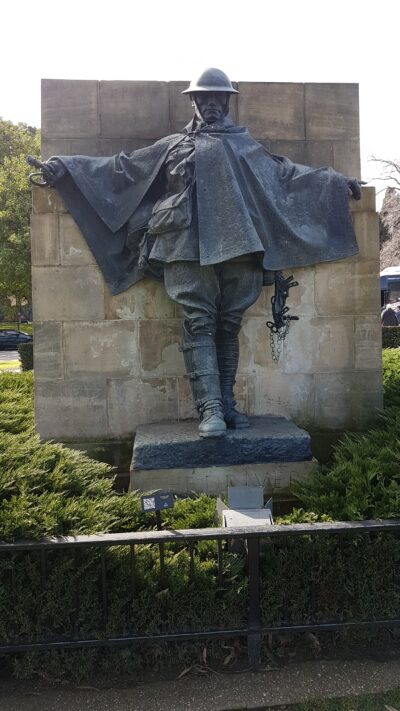
The Driver and the Wipers Memorial, the largest bronze in the collection.
Zora has also been working on condition assessments, testing and treatments for several prominent bronzes in Melbourne that have been in storage, and treatments of various objects including a beautiful 1891 silver cup.
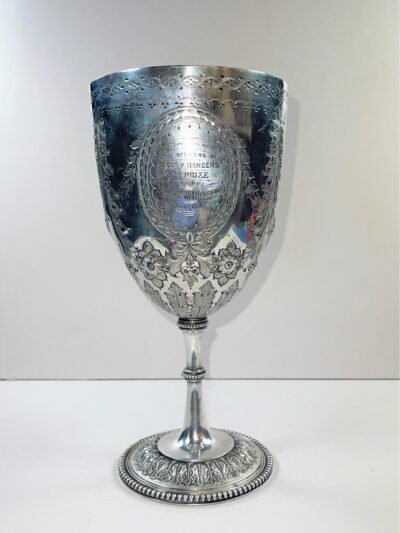
1891 Victorian Rangers trophy, after treatment.
Zora and Sarah Neaves spent a day in the bush assessing several scarred trees that are in the path of a new development, with the goal of finding a way to salvage as many of the culturally significant trees as possible. The trees were assessed by Zora and tested by an arborist and documented thoroughly using photogrammetry.
Eden Christian and Katie Smith worked together on a collections management project in Bendigo, and Eden has been reporting on a storage assessment for multiple collections housed across various sites in Victoria for a Melbourne collecting institution. In addition, Eden has managed several small jobs for private and institutional clients. She is eager to spread the word about her move to Melbourne, bringing her expertise in easel paintings to the Melbourne team.
National Gallery of Victoria (NGV)
General
Michael Varcoe-Cocks, Associate Director, Conservation, has been busy in his role on the steering committee of the design team for NGV-C. Michael and the team continue to work collaboratively with scientists from the Los Angeles-based Getty Conservation Institute (GCI) undertaking research into museum environments. This collaborative research will culminate in a four-day workshop in August co-hosted by the NGV and GCI entitled Changing Climate Management Strategies, which will focus on addressing obstacles in developing and implementing more adaptive environmental management strategies in museums.
Conservation Project Assistant Manon Mikolaitis continues to assist with the auditing, collection management, and preservation planning of the NGV’s time-based media collection, including the digitisation of all Collection works on magnetic tape in line with the NFSA’s ‘Deadline 2025’. Over one third of these works have now been migrated.
MaryJo Lelyveld, Manager, Conservation, and Rahila Merchant, Conservation and Collections Project Assistant, have been busy co-ordinating conservation activities towards Melbourne Now. This exhibition draws from a range of contemporary art disciplines including fashion and jewellery, painting, sculpture, architecture, ceramics, video, printmaking and performance and has drawn across all conservation sections to prepare and assist with installation and documentation. Shown over all three floors of NGV-A and showcasing 200 local artists, it has been a great chance to work directly with the artists, designers and makers to better understand their work.
They have also been working on preventive conservation activities, including monitoring incidents and installing Wi-Fi loggers across off-site collection stores to monitor storage environments, and have updated disaster preparedness response procedures and materials in preparation for May Day.
Paintings
The NGV Painting Team has maintained a balance between major conservation treatments and an exceptionally busy exhibition and loan program. All four members of the team are in the late stages of treatment of Peter Upward Untitled (Blue) (Raymonda Rajkowski), Studio of Rembrandt Portrait of Rembrandt (Caitlin Breare), James Tissot An interesting story (Raye Collins), and Bartolomé Esteban Murillo The Immaculate Conception (Carl Villis). We have devoted much time and preparation towards high-volume loans (WHO ARE YOU to the National Portrait Gallery, and Australiana to the Bendigo Art Gallery) as well as planning for the large NGV exhibition Melbourne Now.
The paintings studio has hosted Conservator of Indigenous Art, Genevieve Sullivan, as she continues her stabilisation treatment of the NGV’s collection of Lajamanu and Papunya panel paintings.
Frames and Furniture
Melbourne Now has been a whirlwind of condition checking and installing works for Suzi Shaw and Holly McGowan-Jackson. Suzi worked on the No House Style display of 13 furniture works and a stunning set of paper lanterns with woven and painted components by artist Jenna Lee. Lighting designer Ilan El provided a great resolution to provide a soft glow from within the lanterns with a new kind of rope LED, hung from a five-metre-high ceiling—a logistical challenge, with three scissor lifts needed for hanging the largest lanterns, which are over two metres tall.
Following 3D scanning training provided by the supplier of the department’s Artec Eva and new Spider scanners, Holly and Jason King have been sharpening their skills, creating scans of frames in the lab and in storage.
Paper and Photography
In the lead up to Melbourne Now, the Paper and Photographs Team has been preparing contemporary and newly commissioned works, currently on display at NGV Australia. Ruth Shervington and Louise Wilson prepared the complex and intricate drawing Priceless worthless Everything nothing Nothing everything No thing a thing A thing no thing A thing by Martin Bell, which consists of 75 large sheets. A hinging system was applied to each sheet so that the work could be hung unframed in a grid-like pattern, seamlessly fitting together across a large wall. Ruth and Louise attached long strips of Japanese paper along the top of the verso of each sheet, which were then threaded through mountboard battens attached to the wall.
Another large-scale drawing prepared was A score for Fed Square by Mia Salsjö, comprising 200+ small sheets with photocopy toner and felt-tipped pen depicting architectural maps and musical scores. Together Ruth, Louise and Bonnie Hearn secured the individual drawings to mountboard pieces using Mylar channels, and attached Velcro to the verso of the mountboard. The drawings were hung similarly, in a grid-like pattern, on the wall, with protective glazing placed in front. The drawing is installed in a small intimate space, accompanied by an audio recording of a musical symphony that references the surrounding works on paper.
Paper conservators also prepared works for Print Portfolio, a collection of commissioned prints by 12 local printmakers, which show a range of contemporary techniques; a selection of historical wills and carte de visite photographs, delicately hand painted by artist Megan Evans for the Wills Project; and a selection of works by 12 Melbourne-based photographers making Slippery Images, which explores an array of photographic processes and formats, hung in unique and innovative ways.

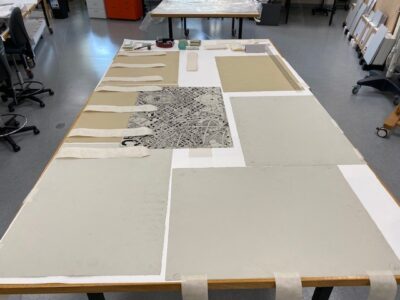
Adhering long strips of Japanese paper to the verso of Martin Bell drawings with wheat starch paste. Image credits: Ruth Shervington.
Exhibitions
Exhibitions Conservation has kicked the year off with the annual Top Arts show. These are Victoria’s top VCE and Studio Arts students from 2021. Janelle Borig and Camielle Fitzmaurice were on site at the Department of Education to make mounting, display and treatment recommendations for the successful students.
Camielle spent a few days at Bendigo Art Gallery installing Australiana: Designing a Nation, in partnership with the NGV. She oversaw the installation of 135 NGV works with the absolutely wonderful BAG team led by Sarah and Charles. This show consisted of works ranging from Depression-era furniture to large oil paintings, sketchbooks, and amazing fashion.

Installing the vignette of John Longstaff, Gippsland, Sunday night, February 20th, 1898, with Victorian blackwood bench. Image credit: Camielle Fitzmaurice.
March kept us all busy with Melbourne Now installing across all three levels of our NGV Australia building at Federation Square. This show consists of over 200 contemporary artists and projects. Janelle picked up Design Wall, working on the mounting and installation of 22 incredible projects showcasing innovation and sustainability in Melbourne design and manufacture. These are mounted across 6m-high scaffolding.
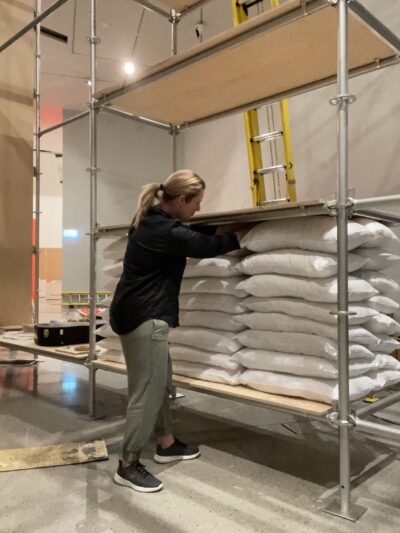
Janelle installing Tontine Group pillows made from 100% recycled materials. Image credit: NGV Installation Crew
Camielle had the opportunity to work closely with artist Lou Hubbard on her installation Walkers with Dinosaurs. This work is made from 400 inflatable walker frames, which were all inflated and placed on-site. Camielle and Lou spent three days together on this project, not only installing but devising an ongoing maintenance strategy.
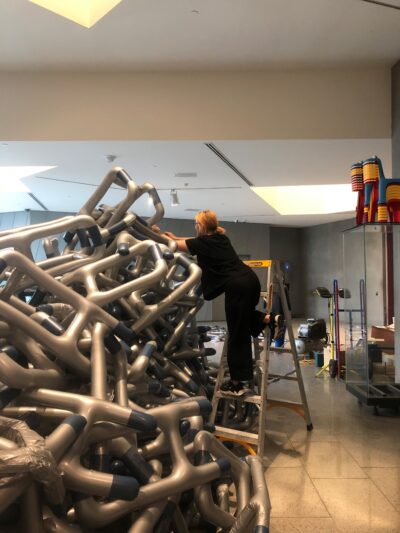
Camielle installing Walkers with Dinosaurs. Image credit: Janelle Borig.
Senior Exhibitions Conservator Catherine Earley worked closely with our mount makers on the Vessels project. The materiality of these works ranged from ceramics to kelp and presented many new challenges for their open display. Working with contemporary art and living artists is a privilege and a learning opportunity, and an example of how agile Exhibitions Conservation is as a section here at NGV.
International Conservation Services (ICS) Perth
ICS Perth has gained several extra members recently to undertake works to murals and wall paintings across the Fremantle Prison UNESCO World Heritage-listed site.
The team consists of Adam Godjin, Alis Jitarescu, Maria Vicente, Francesca Elia, and Bianca Goncalves, assisted onsite by the curatorial team of Olimpia Cullity and Lily Bennion. The ICS team travelled to Perth to work with Claire Rowson on the mural projects from February to April. Works undertaken included overpaint removal, consolidation of cell wall paintings and graffiti, and the transfer of one wall painting that was rapidly deteriorating onto a more stable auxiliary support.
The team also visited the National Trust of WA whilst in Perth, and Claire will be commencing some projects with them in early May.

Maria Vicente and Alis Jitarescu assessing the back of the removed mural.

Bianca Goncalves and Francesca Elia with their completed mural treatment at the Fremantle Prison.

Alis Jitarescu assessing collection items.
WA Division news
Ian MacLeod ventured into the more confined spaces associated with Victoria and so found himself in the National Gallery of Victoria in January to experience the Alexander McQueen exhibition. Oh my gosh, what a stunning set of textiles and outfits and superb showcases, tall, sheer and elegant. I quivered with joy at the fine designs and marvelled at his brilliance. It was like getting to know Mozart by immersing oneself in a continual concert of delight and surprises. The job the designers and exhibition staff did is second to none. If you do get the chance with a discount airfare to Melbourne just jump on the plane and you will not regret it.
While in the culture capital of Australia, I took a drive up to Ballarat for a wedding and a sortie into Creswick to visit the graves of my great-great-grandparents and some of their children. In the Ballarat Cemetery I saw the robustness of granites in my great-grandfather and grandfather’s graves, and they stand up much better than the white hues of marble memorials. My personal joy was complete when I was able to ring on the eight bells of St Peter’s Anglican Church and so complete my 60 years as a ringer where it all began. The Ballarat Art Gallery had some very fine exhibitions, which included five spaces where the originals of Heidelberg School paintings were matched by modern-day versions of the same spot, so that one could see through art the degradation of the landscape. Brilliantly confronting works—congratulations to my home city, and we even found some decent coffee to drink.
Hobart was the next capital city that came into its own in early February for a meeting of the council of Australian Maritime Museums, where workshops demonstrated the robustness of our shared visions for exhibition developments in small and community-based museums, bound together by a common link of a love for matters maritime. The combination of seeking fortunes, of making a permanent home for dispossessed migrants and of establishing the grass roots of Australian maritime heritage, culminated in the Wooden Boat Festival. In a ten-minute session down at the docks I bumped into two former Victorian diving shipwreck colleagues, a visitor from WA and one from New South Wales. There were as many beautiful lines on the wooden boats as on the Oscars ceremonial catwalks.
A quick flight took me up to Sydney to inspect the Australian National Maritime Museum’s Daring class destroyer HMAS Vampire (II) at Garden Island dockyard (HMAS Kuttabul), as it completed a $3-million refit. To stand on the floor of the dry-dock and see the sleek underbelly of the 1950’s warship was most informative in terms of understanding its speed. The shape below the waterline was reminiscent of the denticles on the Megamouth III shark in the WA Maritime Museum on Victoria Quay. A few days later I was lucky enough to be on the ship when it was taken by tugs to its permanent home alongside the ANMM in Darling Harbour. On board were four men who had crewed the ship in the 1960s so it was an honour to be in the company of those experienced veterans. The next week saw me inspecting the treatment regime on the 180-year-old Barangaroo Boat at the facility out at Yennora and then five days inside the hull of Vampire doing in-situ corrosion measurements. It is all part of the improved management plan being developed and managed by Richard Wesley, who is a deputy director of the ANMM. Nicholas Flood was my able-bodied conservator who helped me navigate my way around the fleet collection.
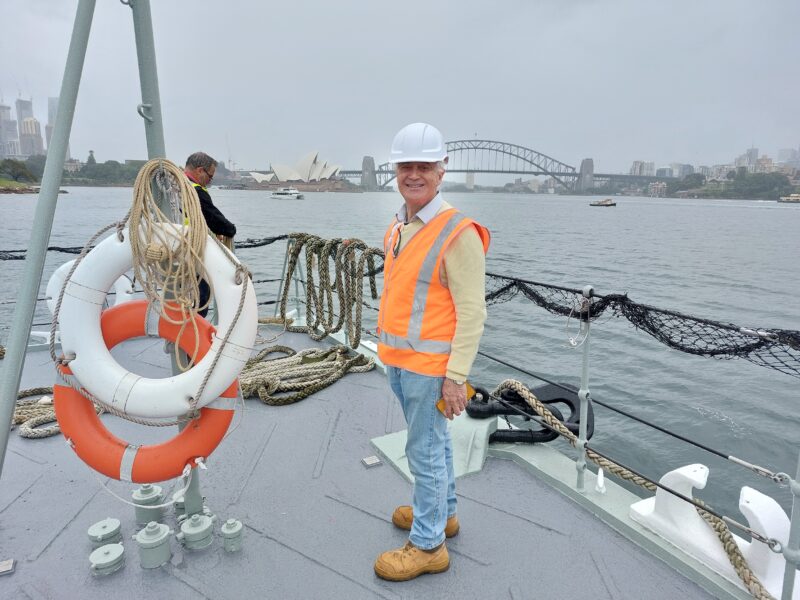
Ian MacLeod on HMAS Vampire, going home. Image credit: Nicholas Flood.
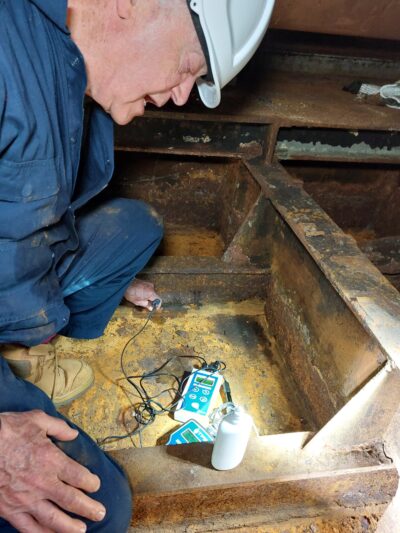
Ian MacLeod at work on HMAS Vampire. Image credit: Nicholas Flood.
Back in WA it was back into action in Belmont Museum, advising on the conservation and exhibition of materials used in the tunnel-boring operation through the City of Belmont that resulted in the opening of the Redcliffe and International airport trainline.